Audit Report on the Department of Parks and Recreation and the Department of Transportation’s Maintenance of Park Bridges
To the Residents of the City of New York:
My office has audited the New York City Department of Parks and Recreation (DPR) and Department of Transportation (DOT) to determine if DPR is adequately maintaining park bridges within its jurisdiction, and whether DOT is adequately inspecting bridges, notifying DPR of its inspection results, and implementing corrective actions as needed. The Office of the New York City Comptroller conducts audits of City agencies such as this to improve accountability and ensure that City resources are used effectively and efficiently.
DPR maintains park bridges in collaboration with DOT. However, the audit uncovered issues with DPR’s oversight of park bridges, including problems with inventory management and maintenance practices. Poor recordkeeping led to missed inspections and delayed maintenance, while prevalent issues such as vegetation overgrowth, structural damage, and corrosion were found during physical inspections of many park bridges.
The audit found that DOT did not conduct biennial inspections of vehicular bridges as mandated and did not consistently conduct annual inspections of pedestrian bridges in parks. It also found that flagged repairs were not resolved in a timely manner.
The deficiencies identified during the audit extended to inconsistent collaboration between DPR divisions and DOT. This lack of communication underscores the need for internal improvements and better coordination between agencies to ensure the timely completion of essential maintenance duties.
Finally, the audit reviewed the accessibility of key park bridges and found that of the 45 bridges critical for geographic equity, 24 were found to be compliant with the Americans with Disabilities Act (ADA); five have projects to improve accessibility in the design/construction process, and 16 were found to be noncompliant. Capital investment is needed to bring all 16 bridges into compliance.
The results of the audit have been discussed with DPR and DOT officials and their comments have been considered in preparing this report. DPR and DOT’s complete written response is attached to this report.
If you have any questions concerning this report, please email my Audit Bureau at audit@comptroller.nyc.gov.
Sincerely,
Brad Lander
New York City Comptroller
Audit Impact
Summary of Findings
The audit identified shortcomings in the New York City Department of Parks and Recreation’s (DPR) maintenance of park bridges, highlighting deficiencies in inventory management and maintenance practices that potentially impact bridge preservation, safety, and future costs. Inaccurate and incomplete inventory lists resulted in bridges being omitted from inspection schedules, which prevented regular maintenance and delayed detection of problems. Maintenance problems such as vegetation overgrowth, damaged structures, and corrosion were prevalent during auditor observations, pointing to a reactive―rather than proactive―strategy that can compromise bridge integrity.
The audit found that the New York City Department of Transportation (DOT) did not conduct biennial inspections of vehicular bridges as mandated and did not consistently conduct annual inspections of pedestrian bridges in parks. The audit also found flagged repairs were not resolved in a timely manner.
The deficiencies identified during the audit extend to collaboration between DPR divisions and the DOT, underscoring the need for internal improvements and better coordination between agencies. The processes for sharing inspection results between agencies should be improved to ensure the timely completion of essential maintenance duties.
Lastly, the audit reviewed the accessibility of bridges that are essential for entry and access to park facilities. Of the 45 bridges that are critical for geographic equity, 24 were found to be compliant with the Americans with Disabilities Act (ADA); 16 were found not to be compliant; and five are in the process of design/construction. Capital investment is needed to bring all 16 bridges into compliance.
Intended Benefits
The audit identified the need for improvements to ensure crucial infrastructure and capital assets are preserved, future repair costs are reduced, and park bridges are safer and more accessible.
Introduction
Background
DPR and Its Assets
DPR is the steward of over 30,000 acres of land—14% of New York City—including more than 5,000 individual properties ranging from Coney Island Beach and Central Park to community gardens and Greenstreets. DPR operates more than 800 athletic fields, nearly 1,000 playgrounds, and 300 miles of trails passing through some of the oldest forests in the City.
City parks are used by millions of people who visit for recreational and educational purposes. According to the Central Park Conservancy, Central Park is one of the most visited urban parks in the United States with around 42 million visitors annually.
Importance of Park Bridge Maintenance
Bridges are integral features of the New York City parks system, ranging from the iconic arched bridges in Central Park to small footbridges over creeks and streams, which provide accessibility, connectivity, and observation points for nature. They also provide access to waterfront areas, such as the East River in Manhattan and across the Belt Parkway in Brooklyn. The High Bridge—New York City’s oldest standing bridge—connects the neighborhoods of Washington Heights in Manhattan and Highbridge in the Bronx and is accessible from both boroughs.
Inspecting and maintaining park bridges are important pieces of overall preservation efforts. Performing regular tasks such as rust removal, painting, cleaning, and clearing vegetation can help extend the lifespan of bridges in the park system. For instance, clogged drains lead to poor water runoff, causing moisture to accumulate on bridge surfaces and penetrate bridge decking. This condition can exacerbate the freeze-thaw cycle, where water trapped in concrete expands when frozen, creating or increasing cracks and accelerating the deterioration of the structure. Additionally, failure to perform painting on a consistent basis can unnecessarily expose steel to the elements and accelerate corrosion and deterioration of steel bridge components. Regular inspections are also essential to the early detection of problems that require larger remediation work and capital investment.
A well-structured bridge maintenance program includes several key components: an accurate inventory, clear standards, and consistent terminology for categorizing bridge structures; a system to promptly identify maintenance and larger capital needs; detailed recordkeeping; and timely execution of maintenance tasks. Implementing such a framework is crucial for effective bridge management.
In this sense, maintenance and capital needs are related.[1] With an average age of over 75 years, most NYC park bridges exceed their typical 50-year design lifespan. Steel and concrete bridges have an estimated lifespan of over 100 years. The longevity of these structures is influenced by a combination of factors, including their design, materials, maintenance, usage, and environmental conditions such as climate, temperature fluctuations, and the use of deicing chemicals. Through effective preservation efforts which include maintenance, rehabilitation, and early identification of capital need, many bridges surpass their expected lifespan.
Charter and Administrative Code Mandates
The New York City Charter, Chapter 21, §533, outlines the powers and duties of the DPR Commissioner, including management, maintenance, and care of parks, squares, public places, buildings and structures. DPR is responsible for maintaining and repairing all bridge structures within its jurisdiction. Such structures include vehicular bridges and pedestrian bridges, including those in parks and those that are part of urban trail systems within parks.[2]
DPR labels park bridge structures on its website and in its asset records and maintenance records using the general term “bridge” or other specific terminology (such as pedestrian bridge, footbridge, trail bridge, etc.). The audit scope covers all bridge structures (bridges under DPR’s jurisdiction), regardless of size or terminology.
The New York City Administrative Code, Title 18, Chapter 1, §18-143 (Local Law 73 of 2015) mandates that the DPR Commissioner submit an annual report to City officials by May 1. This report must identify park facilities that have features specifically designed for people with disabilities and their locations. It must detail facilities assessed for accessibility compliance, reasons for these assessments, and improvement plans. The report must also cover past and upcoming efforts to meet accessibility standards.
The Current Inspection and Reporting Process: Roles and Responsibilities of DPR, DOT, and NYSDOT
Under the Charter, DPR is responsible for maintaining all buildings and structures, including bridges under its jurisdiction. DPR shares responsibility for inspecting certain bridges with the New York State Department of Transportation (NYSDOT) and, by agreement, shares certain inspection and maintenance responsibilities with DOT (see Table I below).
NYSDOT performs biennial inspections of vehicular bridges over 20 feet long. NYSDOT does not repair the bridges it inspects; this responsibility falls to either DPR or DOT.
In 2015, DPR and DOT entered into an agreement (Agreement, or Memorandum of Understanding, or MOU) under which DOT would inspect and maintain bridges listed in the document. When the Agreement was executed, there were 120 park bridges carrying vehicular and pedestrian traffic on the list. As of March 30, 2022, the updated list contained 155 bridges classified by DPR as park bridges.[3]
DPR and DOT update the list regularly to account for any changes—for example, when a new bridge is constructed, when a bridge is found to be omitted from the list, when a bridge is demolished, or when a bridge is assigned to a different agency or organization. DOT may handle inspections and maintenance of other bridges not yet on the list, on a case-by-case basis, pending amendments to the list being finalized.
Under the Agreement, DOT is to conduct biennial inspections of vehicular bridges not inspected by NYSDOT and annual inspections of pedestrian bridges, which may be conducted more frequently if necessary. Additionally, DOT undertakes certain maintenance duties, such as flag repairs (i.e., hazardous, or potentially hazardous safety and structural conditions) resulting from bridge inspections.[4] DOT addresses these conditions by assigning in-house staff, hiring contractors, or by referring the work to DPR.
DPR typically handles other maintenance tasks such as vegetation management, debris cleaning, bridge painting, scupper (drain) cleaning, and maintaining chain-link fences that do not require welding.
DPR operates the Parks Inspection Program (PIP) under which Parks inspectors regularly inspect parks and provide ratings on observed conditions in two-week cycles. The assessment of a bridge’s condition during PIP is limited to flagging observable issues, such as cracked asphalt, uplifted planks, or damaged railings, as would be flagged as hazards along the paths elsewhere in the park. DPR inspectors do not evaluate bridges for structural integrity.
Table I: Summary of Inspection and Maintenance Responsibilities
| Structure Type | Inspection Responsibility | Maintenance Responsibility |
| Vehicular Bridges over 20 feet long – Biennially | NYSDOT | DPR and DOT |
| Vehicular Bridges 20 feet in length or less and Pedestrian Bridges included in the Agreement list – Annually per Agreement
Exceptions: *
|
DOT | DPR and DOT |
| All remaining Park Bridges, and Trail Bridges and Structures. | DPR | DPR |
| * As per the DOT’s 2020 Bridges & Tunnel Annual Condition Report, the East 71st Street Pedestrian Bridge over the FDR Drive (BIN 2232120) is inspected by the Hospital for Special Surgery, and the other three bridges are inspected by DPR or DPR consultants. At the exit conference, DOT indicated that its consultants will be inspecting these three bridges. | ||
According to DPR, identified hazards are communicated to DPR Division of Maintenance & Operations (M&O) management on the same day they are observed. M&O is expected to investigate and take appropriate action. Maintenance and repair work is tracked in the agency’s Asset Management Parks System (AMPS), which tracks work requests generated by staff and Park Supervisors who conduct monthly park inspections. Upon approval of the Supervisor of Mechanics, the work requests become work orders and are closed out after completing tasks.
Bridge inspections by both DOT and NYSDOT can lead to “flag” reports for conditions that may affect safety and structural integrity and are to be addressed in specified time frames, depending on the severity of the condition. DOT coordinates maintenance and repairs with its other offices (When and Where Unit and Flag Engineering Section) and contractors, using DPR intra-city expense funds.[5] DOT notifies DPR when a maintenance need is determined to be DPR’s responsibility. Further, DPR and DOT meet quarterly (more frequently, if necessary) to coordinate and ensure inspections and repairs occur and to discuss any additional funding needs for repairs. When DOT identifies bridge repair work that qualifies for capital investment due to its scope or necessity, it coordinates with DPR to request additional funds for these repairs.
A senior structural engineer (Bridge Project Manager) in DPR’s Architecture & Engineering Division coordinates corrective work within the agency and liaises with DOT. The budget for the upkeep of bridges is included in the overall park maintenance budget. The Agreement stipulates that DPR will pay DOT $2.4 million annually: $2 million for other-than-personal-services (OTPS), and $400,000 to support four full-time positions to manage the bridge program, including inspections. In Fiscal Year 2022, this amount was increased to $4.4 million (OTPS increased to $4 million). On a semiannual basis, DOT submits detailed invoices with supporting documentation to DPR for the work performed by DOT. The senior engineer is responsible for reviewing and approving the payment requests.
DPR provided auditors with an inventory listing of 149 “Natural Area Trail Structures Designated as Bridges.” These trail bridge structures are maintained by a combination of borough M&O staff and a small technical trail improvements team in the Division of Environment and Planning Natural Resources Group. The five-person team maps trail routes and conditions, creates maps for the public, builds and maintains trail structures such as wooden puncheons, trail crossings without footings, water bars, and check steps, and performs inspection and maintenance tasks. They address minor, low-risk repair issues and engage in erosion control activities, such as compacting soil and redirecting water to protect the trails.
Objectives
The objectives of this audit were to determine if DPR is adequately maintaining park bridges within its jurisdiction, and whether DOT is adequately inspecting bridges, notifying DPR of its inspection results, and implementing corrective actions as needed.
Discussion of Audit Results with DPR and DOT
The matters covered in this report were discussed with DPR and DOT officials during and at the conclusion of this audit. An Exit Conference Summary was sent to DPR and DOT and discussed with DPR and DOT officials at an exit conference held on March 1, 2024. On June 6, 2024, we submitted a Draft Report to DPR and DOT with a request for written comments. We received a written response from DPR and DOT on June 24, 2024.
In their response, DPR agreed with four recommendations (#s 1, 3, 4 and 5) and partially agreed with one (# 2); DOT partially agreed with two recommendations (#s 6 and 7) and disagreed with one recommendation (# 8).
DPR and DOT submitted a combined written response. This has been fully considered and, where relevant, changes and comments have been added to the report.
The full text of DPR and DOT’s response is included as an addendum to this report.
Detailed Findings
The audit found deficiencies in DPR’s maintenance of park bridges, including poor inventory management and evidence of inadequate maintenance. The audit’s findings highlight areas where improvements are necessary; in some cases, they also underscore the need for capital investment which would require additional project approval and budget allocation from the New York City Office of Management and Budget (OMB).[6]
The audit’s findings are categorized as follows:
- Poor Inventory Practices: The audit found that DPR’s two inventory lists—one listing park bridges and one listing trail bridges—were inaccurate and incomplete. The audit also found that the practices by which DPR classifies structures as either park or trail bridges are inconsistent, and additionally, found at least 36 bridges that appeared on neither Because they were absent from lists, they were omitted from inspection schedules and did not receive regular maintenance.
- Inadequate Maintenance: The audit identified unaddressed maintenance issues, including unchecked vegetation overgrowth, dirt/trash accumulation, damaged fences, broken and missing handrails, uneven walking surfaces, neglected spot painting, clogged drainage systems, exposed wires, faulty lights, and significant corrosion. Poor maintenance has the potential to undermine bridge safety and increase rehabilitation costs and the need for emergency repairs. For instance, overgrown vegetation can exacerbate existing damage or even create damage by opening cracks in concrete and allowing water to enter the structure, causing accelerated deterioration. During winter, water in the concrete will freeze and expand, causing concrete spalling and growing or creating cracks. Concrete spalls and larger cracks will absorb more water in warm weather and increase the damage caused by freezing water in subsequent winters. Lack of spot painting can accelerate corrosion and require early replacement/repair of structural components.
- Opportunities to Improve Accessibility: Opportunities exist to enhance disability access to bridges that are essential to entering or using park facilities. While DPR has prioritized accessibility in new bridge construction and while performing significant rehabilitation work, many existing bridges fall short of the current ADA standards.[7] In most instances this would require approval of capital projects.
Regarding DOT, the audit found that the agency did not inspect all vehicular bridges biennially or all park pedestrian bridges annually as required under the Agreement with DPR. Moreover, certain corrective actions for flagged repairs were either not completed within a reasonable time frame or remain unresolved when inspected by auditors.
Additionally, while DOT notifies DPR of specific flagged repairs following bridge inspections, the current methods of sharing inspection outcomes—especially in cases where the same issues are repeatedly identified in subsequent inspections—are insufficient to guarantee that all required maintenance tasks are carried out by the responsible agency.
During and following the exit conference, DOT provided explanations and responses for some of the audit’s findings, including future plans. Specifically, DOT intends to adjust the inspection protocol outlined in the Agreement with DPR. DOT also mentioned upcoming implementation of new custom software that will facilitate immediate access to inspection reports and related data upon completion. This is, however, contingent upon resolving synchronization issues with New York State’s database. DOT also attributed the significant corrosion observed during the audit to OMB’s denial of DPR’s funding requests for bridge painting.
Following the exit conference, DPR agreed that the inventory of bridges should be better documented and stated that the bridge inventory shared with DOT is being updated and will be inclusive of all park bridges. DPR stated that trail structure inventory is separate from its bridge inventory. DPR continues to argue that certain bridges that are listed as assets assigned to DPR in other City reports are not “bridges.” However, the explanation given by DPR is inconsistent with DPR’s website, asset records, and maintenance records. Other comments and explanations by DPR have been incorporated into the report, where appropriate.
Bridge Maintenance Hindered by Inaccurate Inventories, Inconsistencies in Policy, and Inadequate Recordkeeping
The foundation of a good bridge maintenance program is complete and accurate data on the bridge structures under the agency’s purview. The inventories maintained by DPR drive the inspection and maintenance program. If a bridge that should be included is left off the inventory, it is unlikely to be inspected on a regular cycle, and if not regularly inspected, it is unlikely to receive regular maintenance that can prevent or delay further deterioration. It also hinders the early detection of larger issues requiring more than routine repair.[8]
The audit highlighted DPR’s difficulty in keeping accurate inventory records. This appears to stem from a lack of formal policies and procedures, as well as inconsistent classifications of bridges and other structures by type. This is important because classification and inclusion in inventory list type determine what level of maintenance occurs and which agency is responsible. DPR must regularly review, update, and reconcile its bridge inventories to ensure that every bridge is properly accounted for and correctly categorized. Additionally, it is essential for DPR to accurately record and monitor the conditions of these bridges.
Of the 36 bridges identified as missing from the inventory, 28 exhibited maintenance problems when observed by the auditors. These issues included peeling paint, overgrown vegetation, broken boards, missing mortar in joints, masonry problems, and steel corrosion.[9]
The details are as follows.
Bridge Inventory Is Incomplete and Inaccurate
According to DPR, as of March 2022, 155 bridges were under its jurisdiction and are on DOT’s list for inspection and maintenance. The list includes 10 of the 149 bridge structures located in park trails that DPR is responsible for inspecting and maintaining. Also, DPR purports to exclude bridge structures shorter than 20 feet long, which DPR says are not officially “bridges” (DOT classifies them as “mini-bridges”). However, the audit identified bridges that were over 20 feet long that were not included in DPR’s list, and others that were, even though they were under 20 feet long. Further, the audit identified 36 bridge structures that were omitted from both the MOU and trail bridge inventories.
Overall, after adjustments to DPR’s inventory data and the inclusion of the 36 omitted bridges into DPR’s inventory lists, the auditors determined that at least 322 bridges and trail bridges are under DPR’s jurisdiction and should be on its inventory lists. This consists of 192 bridges that should potentially be listed in the agreement with DOT, plus 130 trail bridges managed directly by DPR. See the details below and Table II for a reconciliation of inventory.
- Bridges on the list of 155 bridges are under DPR jurisdiction and are on DOT’s list for inspection and maintenance. The list includes 10 of the 149 bridge structures located in park trails that DPR is responsible for inspecting and maintaining (i.e., also on the 149-trail bridge list).
- After assessing the bridge structure type and locations of the newly identified 36 bridges, the auditors suggest that 31 of these could be categorized under the bridge list, while the remaining five are more suited for the trail bridge list.
- Additionally, the auditors found discrepancies in the existing list of 149 trail bridges: one structure was actually a New York State bridge; six were duplicate entries; 10 were already included in the list of 155 bridges; and one had been demolished by DPR due to hazardous conditions identified by the auditors.[10] Furthermore, the auditors recommend reclassifying six bridges from the trail bridges list and adding them to the list of 155 bridges covered by the MOU.
- This adjustment would result in a total of 192 bridges (comprising 155 original, plus 31 new, and six reclassified as bridges) covered by the MOU with DOT and 130 trail bridges (149 original plus five new, minus one State bridge, six duplicates, 10 already listed, one demolished, and six reclassified).
Table II: Reconciliation of Bridge and Trail Bridge Inventory

36 Bridges Omitted from Inventory
The auditors identified at least 36 bridge structures categorized as either bridges or trail bridge structures that should be reviewed for addition to the agency’s park bridges inventory. These unlisted bridges were discovered by the auditors through site visits to sample bridges, analysis of the agency’s PIP data, NYC Open Data records, Asset Information Management System (AIMS) reports, and examining aerial images of parks.[11]
The auditors followed up with DPR about the status of 18 bridges found in the early phase of the audit for which DPR provided explanations. One trail bridge structure had been demolished (after the auditors notified the agency), one would be placed on the list of 155 bridges, one was less than 20 feet in length, and for the remaining bridge structures, DPR will work with DOT to determine whether they should be considered bridges. Later in the audit, the auditors found an additional 18 bridges. This list was shared with DPR.
See Appendix 1 for a list of 36 omitted bridges.
Inconsistent Classification of Bridges
Some of the 36 additional bridge structures identified by the auditors were 20 feet long or less, and DPR claims to have left some of them off the inventory list of 155 bridges because they only consider structures over 20 feet long to be bridges. DPR relies on the definition of “bridge” that appears in Chapter 25 of New York State Law (Highway Law) and Title 23 of the Code of Federal Regulations (Highways) to make this distinction. However, these definitions apply only to structures defined as highway bridges on highways and public roads. They do not apply to bridge structures within trails or to pedestrian bridges within the park system.
During and following the exit conference, DPR insisted that it follows the legal definition of a bridge when compiling the bridge inventory. However, the audit found that the definition is not applied consistently or correctly by DPR.
The City Charter does not limit DPR’s responsibility for park bridges based on length of structure, and as noted above, DOT classifies bridges that are 20 feet in length or less as “mini-bridges.” These are not excluded by DOT in the City inventory, and, in fact, the auditors found that DPR does not consistently do so either; several structures that are 20 feet long or under do appear in DPR’s inventory of bridges.
At least 10 structures on the list of 155 bridges are 20 feet in length or less and appear on DPR’s list as bridges. The smallest is only 12 feet long and is in Manhattan’s Fort Tryon Park (Bridge Identification Number [BIN] 2245050). This bridge was included on DOT’s list of bridges and has been inspected by DOT since 2000. Other examples include at least four of the five bridges in Queens’ Brookville Park, Manhattan’s Central Park (Inscope Arch, BIN 2246040), and Brooklyn’s Prospect Park (Cleft Ridge Span, BIN 2244060).
The five bridges in Brookville Park that are included in DPR’s inventory of bridges appear under the following BINs: Q-00003, Q-00004, Q-00006, Q-00007 and Q-00008. According to DOT, the “Q” indicates that these are “mini-bridges” located in Queens. In DOT Bridge Inspection Reports, all Brookville Park bridges except Q-00008 were listed as 20 feet in length or less; the length of Q-00008 was not provided in the DOT Inspection Report. Following the exit conference, DOT stated that all of these bridges were close to 20 feet or greater and in the same vicinity, and were therefore added. DOT indicated that they are trying to add as many structures as possible given staffing levels and funding.
All five bridges in Brookville Park were added to the DOT Bridges and Tunnels Annual Condition Report in 2020 on the Inventory Adjustment page under DPR’s jurisdiction. It should be noted that, during the audit, the auditors questioned the reasons for the addition of these bridges in 2020, as they seemed to have been built much earlier. In response, DPR explained that “Q00003, Q00004, Q00006, Q00007, and Q00008 were identified as bridges originally thought not to meet the [New York] State criteria for a bridge, but were later identified as meeting those thresholds and, as such, were added to the MOU.”
DPR’s response underscores the lack of clarity and consistent policy as to what should and should not appear in DPR’s bridge inventory. This is not a matter of technicalities. All bridge structures within the park system should be properly inspected and maintained, for safety if for no other reason. Some of the omitted bridges were found by the audit team to be in poor condition and presented potential safety hazards, evident in the following section which shows the risks of misclassifying bridge structures.
Neglected Maintenance of Tidal Marsh Bridge (Brooklyn)
The Tidal Marsh Bridge in Brooklyn’s Marine Park is one of the bridges omitted from DPR’s list of 155 bridges and was not included in DOT’s Bridges and Tunnels Annual Condition Report, even though it has been listed in successive AIMS Reports as a DPR asset. This highlights the deficiencies in the inventory process; at a minimum, DPR should ensure that all bridge assets listed in the AIMS Report also appear on the list of bridges due for regular inspection and routine maintenance.
The AIMS Report is based on surveys conducted approximately every four years by engineers hired by OMB to assess the capital needed to maintain costly assets in a state of good repair.[12] The AIMS Report is not designed to ensure routine maintenance; this falls to DPR. However, because this bridge was left off DPR’s inventory list, it was not inspected annually and did not receive routine maintenance as it should have.
In FY2017, the AIMS Report noted light corrosion occurring only over “20% of one bridge component (Superstructure/Primary Member Steel),” calling for $81,000 in repair costs. Had the bridge been included in the inventory for maintenance, this small amount of corrosion could have been addressed by routine maintenance, which could have prevented or delayed its spread.
By FY2023, the AIMS Report noted the same bridge component with moderate corrosion of over 75% of the structure, now requiring a significant capital investment of $475,000 to repair. Once corrosion spreads to this extent, it becomes a larger project requiring separate project and capital budget approval. This example highlights the relationship between regular maintenance—which is needed to prevent further deterioration—and increases in capital need when that maintenance does not occur.
The audit observations of the Marine Park Tidal Marsh Bridge conducted in April 2023 identified similar issues to those found in the FY2023 AIMS Report (see photos below), as well as certain accessibility problems that are discussed later in the report. Despite its inclusion in the AIMS Report, as of this writing DPR is still debating whether it is a bridge structure that should be included in the agency’s list of 155 bridges.
Conditions Observed at Marine Park Tidal Marsh Bridge, Brooklyn
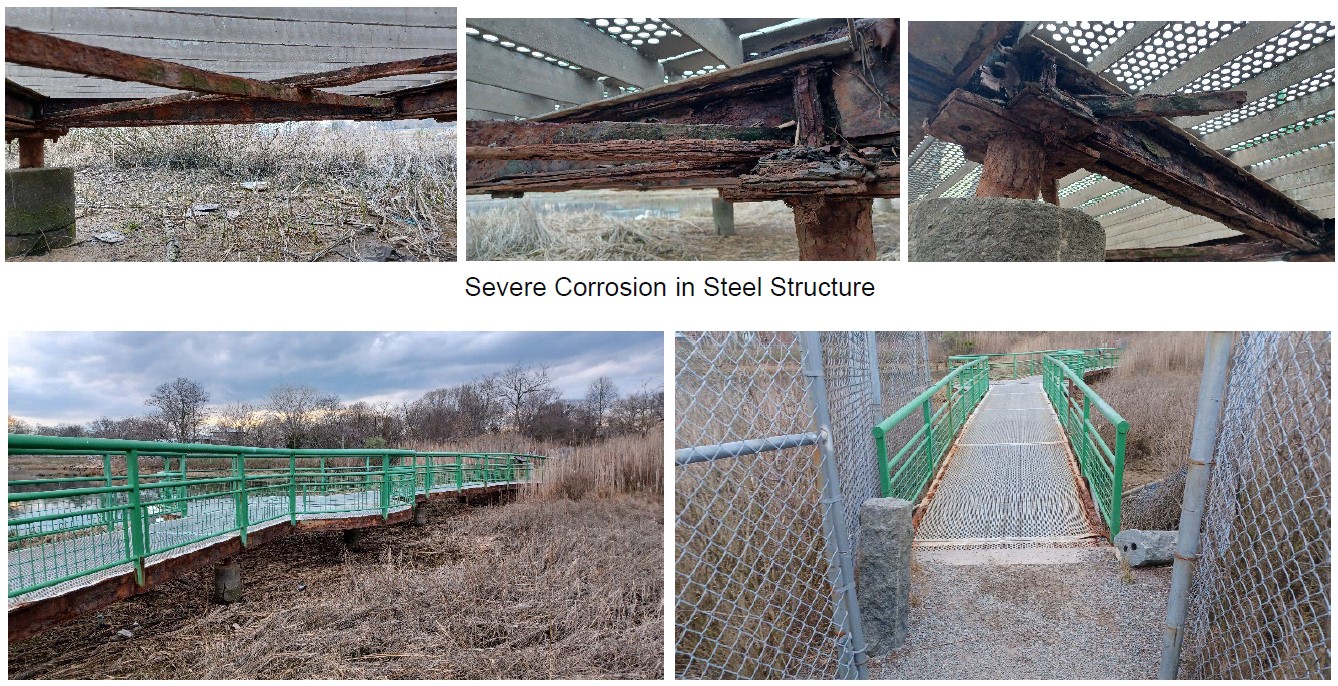
DPR continues to assert that the nearly 100-foot bridge does not meet the NYS definition of a bridge because the individual spans max out at 18.5 feet. However, DPR is misinterpreting State and federal regulations regarding how the length of a bridge is measured. The relevant distance is determined by measuring between the end supports (or abutments), rather than measuring between individual supports.
DPR also asserts that this structure is monitored under the NYC Economic Development Corporation’s (EDC) Waterfront Facilities Maintenance Management System and was inspected in 2023. DPR stated that inspections of waterfront properties are conducted by EDC, not DPR. However, there are other bridges that are on the waterfront and are inspected and maintained by DOT, such as the bridge in Lemon Creek Park (Staten Island), which appears on the list of 155 bridges. Once again, this points to the lack of clarity in determining which bridges should appear in the inventory, which agency is responsible for inspecting them, and resulting gaps in maintenance.
Following the exit conference, the auditors obtained and examined EDC’s inspection records. These records show that EDC first inspected the Tidal Marsh Bridge in 2023. This inspection found the structure to be in a serious condition and recommended a replacement in 2024 on a priority basis. There are no records indicating prior inspections and/or maintenance by any agency.
Neglected Maintenance of Bridge Omitted from Inventory
One bridge near Drumgoole Road West in Bloomingdale Park in Staten Island was omitted from DPR’s list of 155 bridges and was not on any DPR inventory list. This bridge was built around 2004, making it approximately 20 years old. A bridge of this type has a potential useful life exceeding 100 years, if supported by proper maintenance. However, there are no records of inspection or maintenance having occurred.
Auditors discovered this bridge during observations conducted in June/July 2022. It was found to have extensive steel corrosion under the bridge deck, resulting in detached beams and compromised load-bearing capacity (see photos below). Following notification, DPR and DOT acted promptly and inspected the bridge, and then closed it to vehicular traffic. During a follow-up visit in March 2023, the auditors confirmed that yellow protective bollards had been installed at both ends of the bridge to prevent vehicle access. (See photos below.)
DPR stated that DOT would conduct ongoing inspections and monitor the bridge’s condition. Additionally, DPR and DOT plan to collaborate on estimating the cost of replacing this bridge and updating the bridge inventory.
Conditions Observed at Bridge Near Drumgoole Road West, Bloomingdale Park, Staten Island
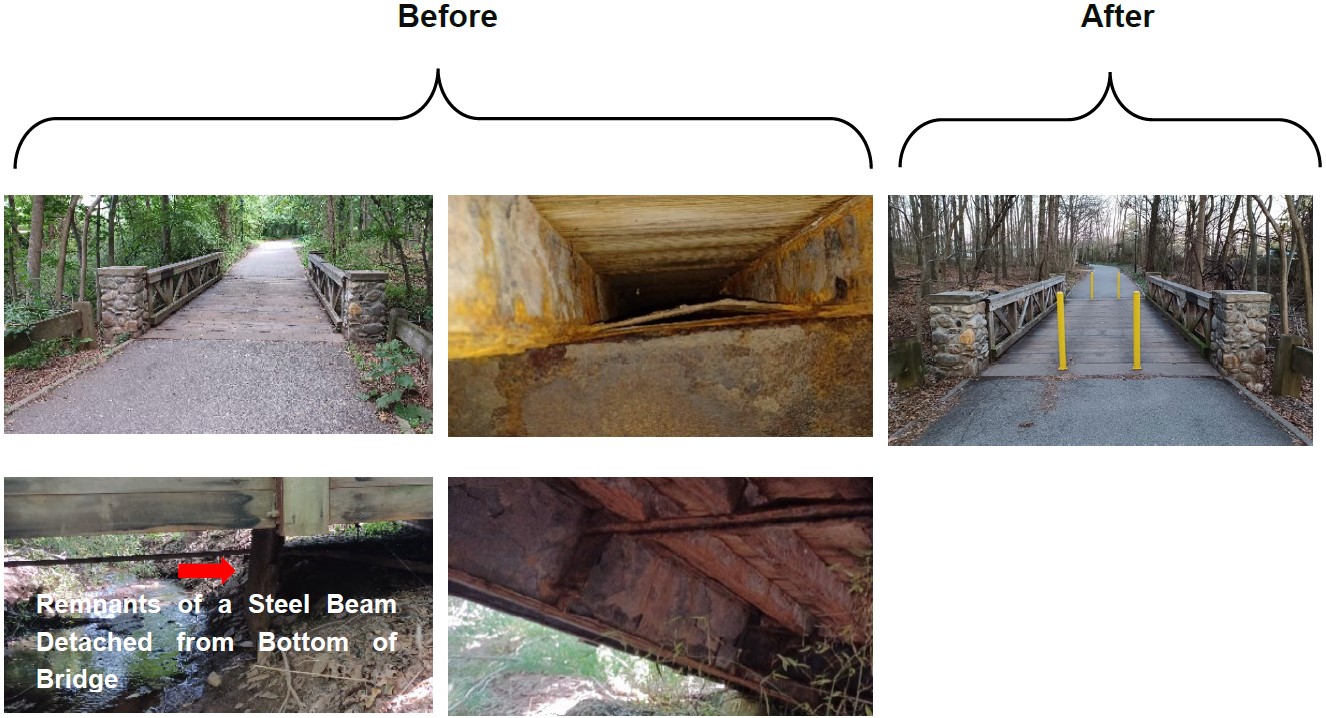
Incorrect Locations, Switched BIN Numbers, and Inconsistent Handling of Inspection and Maintenance Work
In addition to omissions and the inconsistencies noted above, the list of 155 bridges maintained by DPR was also found to contain inaccuracies in location, mismatched Bridge Identification Numbers, and inconsistencies in inspections and maintenance practices. Examples of these discrepancies are as follows:
- Two bridges in Central Park, near the southeast and southwest of the Reservoir, appeared on the list with switched coordinates.
- Several structures were listed with inaccurate locations but with correct BINs, including:
- In Prospect Park, Esdale and Music Grove bridges have swapped BINs (2244090 and 2244100). Also, Esdale Bridge has a BIN Plate with BIN 2244100 attached, which belongs to Music Grove Bridge. Music Grove Bridge has been missing the BIN Plate since at least 2017 when DOT inspectors reported it.
- A bridge in Manhattan’s Inwood Hill Park has inaccurate GPS coordinates, with its actual location being over 600 yards to the north of the recorded position.
- Two bridges located approximately 700 yards apart—one wooden bridge at the north end of the lake in Van Cortlandt Park (Bronx), and another metal/concrete bridge on the south end of the lake—were found to have been assigned the same BIN number (2271600). In addition, they appear to have been handled differently. The bridge to the north does not appear in DPR’s 155 bridges inventory, but DOT inspected it at least three years in a row starting in 2020 and performed substantial structural maintenance work. The bridge to the south does appear on the list of 155 bridges but has not been inspected or maintained by DOT.[13]

Inaccuracies in Trail Structure Inventory
DPR provided auditors with an inventory listing of “Natural Area Trail Structures Designated as Bridges,” approximately 10 months into the audit. The list included 149 structures unofficially designated as “trail bridges” by DPR. Although the agency submitted this list of trail structures, DPR officials from the Division of Environment and Planning (E&P) stated that the list was incomplete, and although the structures are called bridges in their system, DPR contends that they are not bridges and they plan to update the terminology.[14] The auditors found this list incomplete and inaccurate.
Auditors identified several errors in the list, including six duplicates and 10 bridges that also appeared on the list of 155 bridges initially provided by DPR.
The following 10 bridges appear on both bridge lists:
- One bridge in Fort Washington Park, Manhattan
- Two bridges in Van Cortlandt Park, Bronx
- One bridge in Pelham Bay Park, Bronx
- One bridge in Highland Park, Queens
- Four bridges in Clove Lakes Park, Staten Island
- One bridge at William T. Davis Wildlife Refuge (Freshkills Park), Staten Island
Auditors also identified a NYSDOT bridge in Cunningham Park (Queens) spanning the Clearview Expressway (I-295) that was mistakenly included on the list of 149 trail bridges.
DPR officials from E&P stated that the list of unofficial trail structures designated as trail bridges was generated in December 2022 and was inventoried by a small, rotating group of staff while walking the trails in the natural areas of DPR properties.
The E&P officials stated that the list did not include all the bridges for which they were responsible and acknowledged the need to both update the list and reevaluate their classification of these structures. Additionally, E&P officials stated that trail structures do not receive regular maintenance. E&P works with other DPR groups to address maintenance and repair needs. See photos below of typical trail bridges from the list provided to the auditors by E&P.
Examples of Trail Structures Categorized in Inventory as Trail Bridges from List Provided to Auditors by DPR Environment and Planning Division
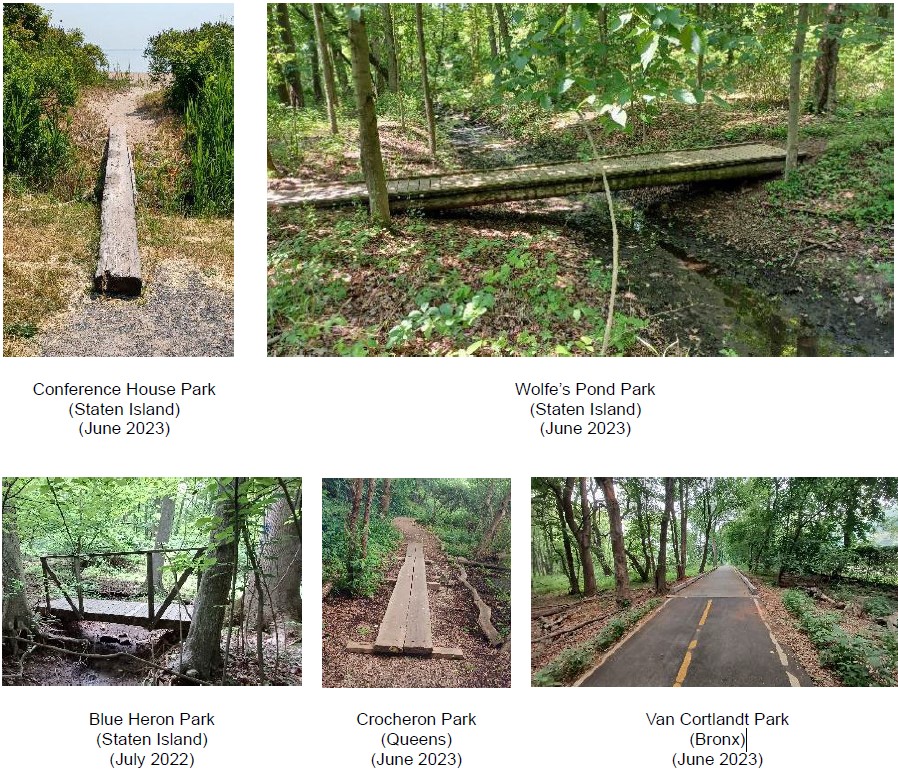
The auditors identified similar trail structures in King Fisher Park in Staten Island that were not on any lists (see photos below).

Two trail structures in King Fisher Park (Staten Island)
(Photos by Auditors – June 2022)
The auditors also found that a trail bridge structure in Willowbrook Park (Staten Island), despite being on DPR’s trail bridge inventory, showed signs of neglect. DPR explained that this bridge was shorter than 20 feet and located on a “decommissioned and unmapped trail.” However, the auditors did not notice any signs or barriers indicating that the bridge was “decommissioned” or closed. In response to the audit, DPR has demolished the bridge.
Conditions Observed at a Trail Bridge Structure in Willowbrook Park, Staten Island

Safety Conditions Found at Omitted Trail Bridges
As mentioned earlier, of the 36 additional bridges found, five seemed to be trail-bridge-type structures. The auditors noted a lack of maintenance at three of these five bridge structures. At Bloomingdale Park in Staten Island, one bridge was found with several concrete blocks underneath, obstructing natural water flow, and at least one decaying timber plank. Additionally, one of the small footbridges in King Fisher Park in Staten Island also exhibited wood decay. The other footbridge in King Fisher Park appeared to be partially supported by an automobile tire, and several of its boards were broken at the ends (see photos below).
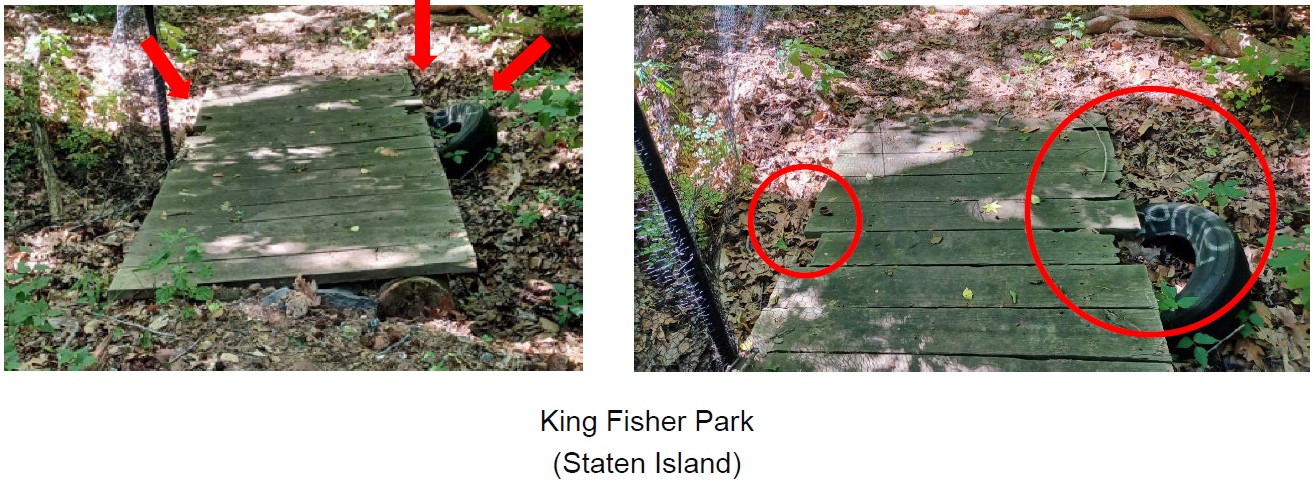
Inadequate Recordkeeping
The audit found that DPR lacks documentation for bridge inspections and visual records of bridge conditions noted by its inspectors. No standardized checklist is used for bridge inspections, and inspectors are not trained to check park bridges. Instead, these structures are evaluated as part of the park’s other features within the agency’s PIP process.
The agency does record detailed information about corrective actions (such as issued work orders) for various park assets in its AMPS system. It also captures detailed information for general routine maintenance that can be grouped and analyzed in many ways, including at the park level. However, spending records cannot be linked to individual bridges.
Inadequate records make tracking past maintenance activities for a specific bridge challenging and hinder effective maintenance planning, prioritization, and accurate budget allocation. Based on the records provided by DPR, the auditors were unable to independently determine which bridges have undergone corrective maintenance or calculate the total expenditure per bridge over a duration of time.[15]
Inadequate Maintenance of Bridges
DPR is responsible for maintaining all vehicular and pedestrian bridges, including those in the City’s urban trail network. According to its Agreement with DOT, DPR performs specific maintenance tasks comprised of cutting plants, trees, and any other vegetation; cleaning debris on, around, and under bridges; painting components of bridges (on/around); cleaning of scuppers (i.e., drains); and maintenance of chain link fences which do not require any welding. DOT performs inspections of park bridges and flags repairs on behalf of DPR under the Agreement between the two agencies. According to the Agreement, if DOT identifies bridge repair work that qualifies for capital investment, it coordinates with DPR to request additional funds for such repairs. DOT also assigns corrective work resulting from bridge inspections to DPR.
DOT is responsible for inspecting specific bridges regardless of their size, as agreed with DPR. According to the Agreement, pedestrian bridges are subject to annual inspections.
The audit found a range of safety and structural problems resulting from a lack of or inadequate maintenance.
Deficient Bridge Conditions Observed
The auditors conducted observations at 86 bridges (see Table III below) and found evidence of gaps in DPR’s and DOT’s maintenance. These have led to structural deficiencies at multiple bridges, such as corrosion and cracks, that may require immediate and more expensive repair. Cumulatively they point to inadequate maintenance practices which could accelerate bridge deterioration.
The auditors’ observations identified the following types of issues:
- Clogged drains and vegetation overgrowth were found on most of the bridges visited by the auditors. Such conditions are more than merely aesthetic; they pose significant safety and structural threats. Clogged drains lead to poor water runoff, causing moisture to accumulate on bridge surfaces and penetrate bridge decking. This leads to persistent dampness which can accelerate wear and corrosion, which in turn can undermine the structural integrity of bridges over time. Overgrown vegetation can also conceal structural problems, hinder inspections, and exert pressure on structural elements, exacerbating existing damage or even causing new issues. These conditions indicate infrequent cleaning and removal of vegetation and dirt/trash accumulation.
- Safety hazards that pose risks to bridge structure or to park-goers were observed at multiple bridges, highlighting the urgent need for targeted repair and maintenance work to mitigate risks. This included exposed steel beams and gaps in concrete; the occurrence of efflorescence points; compromised fences, intended as safety barriers; uneven walking surfaces and tripping hazards; and broken or missing handrails.
- Deferred and infrequent bridge painting was observed across the system. Regular painting acts as a protective barrier, shielding bridges from environmental damage such as corrosion and wear. Neglecting this necessary maintenance can accelerate material deterioration, shorten the bridge’s lifespan, and lead to expensive repairs or replacements.
Following the exit conference, DOT attributed the significant corrosion observed during the audit to OMB’s denial of DPR’s funding requests to paint its bridges. The auditors obtained a copy of one such request from DPR (see Appendix 4) which sought $846,549 in PS and $800,000 in OTPS annually to cover the cost of painting nine steel bridges each year, using internal resources, and a further $5.5 million to hire contractors for painting during FYs 2023, 2024, and 2025. The request contained the following justification: “It has been noted by DOT inspectors that many Parks steel bridge structures have deteriorated prematurely due to a lack of protective coating to prevent corrosion. Completing this work in a timely manner, in accordance with industry standard practices, will extend the useful life of all steel components in the bridges, thereby avoiding costly capital projects or potentially hazardous situations.”
In denying the request, OMB effectively prevented DPR from performing cost effective maintenance. This shortsighted approach leads to worsening corrosion and the likelihood of increased repair costs and greater capital need if larger rehabilitation and/or replacement become necessary.
- Partially blocked water flow conditions under some bridges were found. This leads to increased water pressure, putting stress on bridge foundations, and erodes water-level bridge structures when not cleared for long periods of time. The risks associated with the erosion of water-level structures range from gradual loss of material to sudden structural failure during extreme weather conditions.
The table below summarizes needed maintenance and repair work identified during auditor observations at 85 of the 86 sampled bridges.[16] This is detailed in Appendix 3; each of the conditions cited in Appendix 3 fall within the scope of DPR’s maintenance responsibilities.
Of the 85 bridges, the auditors observed excess vegetation on 35 bridges and excess debris on 13 bridges, peeling paint on 22 of 60 bridges with painted surfaces, clogged drains on 19 of 74 bridges with drains, and damaged fences on 9 of 55 bridges with fences.
Table III: Quantitative Summary of Audit Observations
| Excess Vegetation | Excess Debris | Peeling Paint | Clogged Drain | Damaged Fence | |
| Number of applicable bridges | 85 | 85 | 60 | 74 | 55 |
| Number of bridges where maintenance deficiencies were observed | 35 | 13 | 22 | 19 | 9 |
| Maintenance Deficiencies (%) | 41% | 15% | 37% | 26% | 16% |
Poor Remediation of Identified Issues
According to DOT’s inspection reports from 2017 to 2022, 19 of the 85 bridges have recurring maintenance issues, each with one or more pending flag packages consisting of 61 corrective maintenance repairs (CMRs). The CMRs called for maintenance to address cracks, spalls, uneven surfaces, corrosion, deteriorated paint, and other issues. Out of the 61 CMRs identified on these bridges, 10 were under the purview of DPR, 48 were DOT’s responsibility, and three were assessed as not requiring a flag. Forty-four of these CMRs remain unresolved, including 13 that have remained unresolved since 2018. Appendix 5 contains details of each of the conditions observed; most fall within DOT’s maintenance and repair responsibilities.
For example, the East 10th Street Pedestrian Bridge (BIN 2233020) over the FDR Drive at John V. Lindsay East River Park in Manhattan appears on the DPR list, and DOT regularly inspects it. Inspection reports from 2017 to 2021 identify recurring problems—such as corrosion, rust, clogged drains, missing components, exposed electrical wires and corroded electrical utility box. While some issues have been addressed, others remain open and overlooked. Some issues, first flagged in 2016, remain unresolved. Following the audit, DOT indicated that the Division of Bridges has sent a repair request for the Street Lighting division to address the electrical issues, which pose a safety hazard.
Deficiencies in Bridge Maintenance Found at East 10th Street Pedestrian Bridge (BIN 2233020) over FDR Drive at John V. Lindsay East River Park in Manhattan
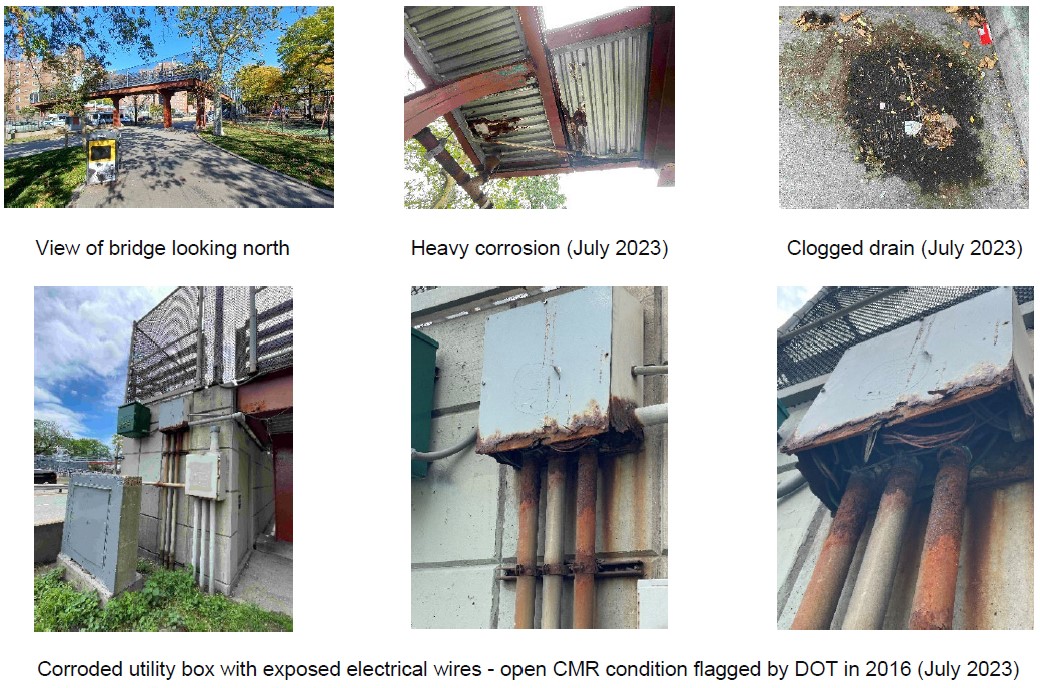
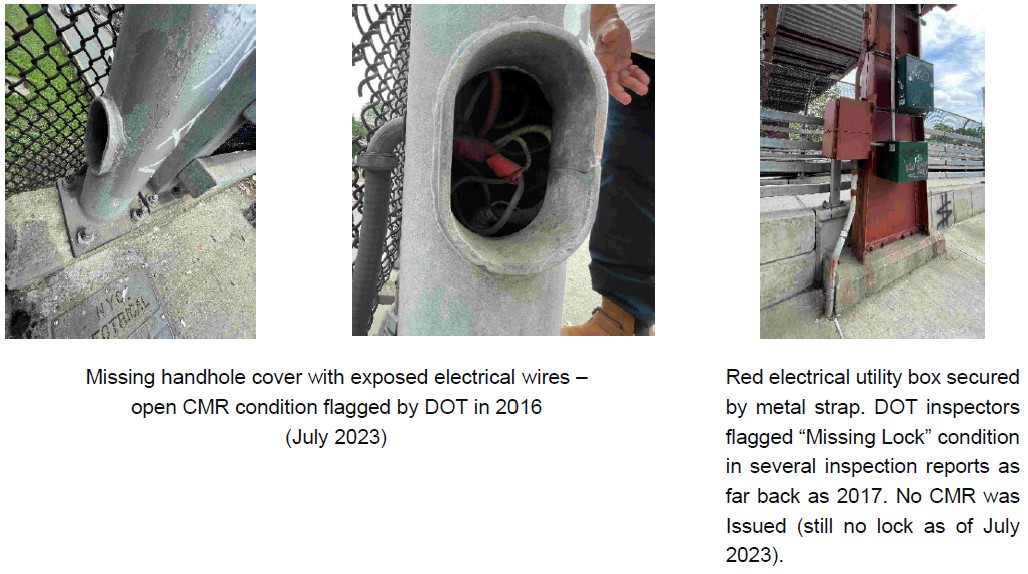
See Appendix 5 for the status of outstanding maintenance and repairs.
As shown in the photos above, conditions such as exposed electrical wiring, clogged drains, heavy corrosion, and excess debris were not corrected by either DPR or DOT. Some of these pose hazards to the public, some potentially compromise the structural integrity of the bridge, and others could increase mitigation costs if not addressed promptly. Both agencies could have coordinated the work and corrected the conditions.
Following the exit conference, DOT stated that additional funding and/or personnel are needed to address conditions found at all bridges. A licensed DOT Professional Engineer reviews all flags and prioritizes repairs needed to ensure the safety of the public. Some conditions, however, are not considered by DOT to be hazardous to the traveling public. These are only routinely monitored to save scarce expense funds, with repairs deferred to upcoming capital contracts.
This indicates a need for strategic collaboration between the agencies to address bridge maintenance, and an agreed approach for when a greater capital investment is needed. The agreement between DPR and DOT is primarily focused on corrective maintenance. According to the Agreement, if DOT identifies bridge repair work that qualifies for capital investment due to its scope or necessity, DOT coordinates with DPR to secure additional funding for these repairs. However, the Agreement does not provide details on initiation of capital funded repairs or alternate resolutions when funding for repairs is unavailable.
Need for Improved DOT Bridge Inspections and Maintenance Coordination
DOT plays a critical part in the maintenance of park bridges. However, the audit found that DOT does not always adequately inspect bridges. The auditors determined that two of the four vehicular bridges were not inspected biennially, and 50 (88%) of the 57 pedestrian bridges were not inspected annually, as stipulated in the Agreement.[17] Furthermore, at least one of the five inspection reports was missing from the reports provided by DOT to the auditors for the years 2017 through 2022.
Also, required corrective actions related to maintenance and repairs were not completed within a reasonable time; some have remained unaddressed for several years. Although DOT notifies DPR of work it determines should be performed by DPR following bridge inspections, the current practice of sharing bridge inspection results—especially when the same conditions are noted repeatedly during subsequent DOT inspections—is inadequate. The current process does not ensure that both agencies are performing all necessary maintenance. These shortcomings in DOT’s inspection and repair practices contribute to inadequate bridge maintenance and communication gaps between the agencies.
Opportunities to Improve Bridge Accessibility and ADA Compliance
DPR is committed to creating equitable public spaces for all New Yorkers through its “DPR: Framework for an Equitable Future.” Initiatives like the $150 million Anchor Parks Initiative and the Parks Without Borders program aim to improve park accessibility and quality.
In 2015, as part of OneNYC, $50 million was dedicated to the “Parks Without Borders” program to make parks more accessible, and the current administration has renewed its commitment to ensuring park equity and accessibility for all residents.
Under the 2015 Plan, Van Cortlandt Park in the Bronx, Prospect Park in Brooklyn, and Flushing Meadows Corona Park in Queens were designated showcase projects of the program. All three contain bridges under DPR’s jurisdiction.
When considering equity and accessibility for individuals with disabilities, the City is held to standards established in the Americans with Disabilities Act (ADA).[18] Under the ADA, new construction and alterations of facilities (including bridges) after 1991 must comply with specific standards. There are bridge features that play a role in determining how accessible bridges are to all users. These include slopes, handrails, the clear width of pathways, the condition and accessibility of approach paths, and the existence of obstructions.
Accessibility Observations Conducted at 29 Locations
From the list of 155 bridges provided by DPR, the auditors determined that 45 of these locations are critical for geographic equity to help members of the public cross an obstruction (such as a major highway, railroad tracks, or a body of water), or to access facilities or amenities available to the public on the other side of an obstruction.[19] In some cases, a detour may not be convenient or possible to get around an obstruction, thus depriving a casual park user from using the park’s facilities at the desired location. This is especially prevalent in parks abutting highways and waterfronts, such as the FDR Drive and Hudson River in Manhattan, the Belt Parkway in Brooklyn, the Cross Island Parkway in Queens, and the Bronx River in the Bronx.
The auditors conducted accessibility observations at 29 such locations. For the remaining 16, the auditors analyzed the information contained in the DOT Inspection Reports and other sources, such as Google Street View. The auditors identified limitations on accessibility for bridges and found that many bridges fall short of current ADA standards.
Of the 45 bridges, 24 were found to be compliant with ADA standards, and five more were in the process of design/construction. A further 16 bridges are not compliant and will require capital investment—and the approval of OMB—to achieve ADA compliance.
In limited circumstances, smaller scoped work could improve accessibility while approval to conduct capital projects is pending. For example, the auditors identified a compliance issue with the Tidal Marsh Bridge at Marine Park (see photos below). Although the hiking trails in Marine Park are listed as ADA accessible on DPR’s website, the bridge is not. According to ADA standards, a maximum change in elevation of ¼ inch is allowed, but the auditors found a change in elevation of 1¼ inches. This could be corrected by resurfacing the bridge, within the existing maintenance and repair budget.
ADA Compliance Issue: Tidal Marsh Bridge (No BIN) in Marine Park, Brooklyn

See Appendix 6 for photos of examples of ADA compliance and safety issues.
Capital Investment Needed to Achieve Accessibility
Twenty-four of the 45 bridges deemed critical for accessing City parks or getting from one section of a park to another were deemed ADA accessible by the auditors.[20] Sixteen bridges were not ADA accessible. At the other five locations, the bridges were in design/construction phases, with one project canceled.
It should be noted that ADA requirements took effect in 1992 and any existing structures prior to the enactment of the law are not required to be upgraded. However, any new construction or major rehabilitation work (with few exceptions) must comply with ADA Standards.[21] [22]
See Appendix 7 for a summary of ADA accessibility with relevant Community District Profile information, including Household Income and Access to Park data.
DPR has prioritized accessibility in new construction and projects to replace existing bridges. For example, a new bridge was built across the Bronx River at Starlight Park in 2012, linking Community Districts 3 and 9 on both sides of the river. Additionally, between 2020 and 2023, three additional bridges were completed at Starlight Park, crossing the Bronx River and railroad tracks, and providing residents on both sides of the river with access to Starlight Park and Concrete Plant Park.[23] Where this requires a capital investment, DPR requires OMB approval to proceed with planned improvements.
For example, a recent project in Van Cortlandt Park that would have connected trails and communities on both sides of the Major Deegan Expressway was canceled. This project, included in the 2014 Van Cortlandt Park Master Plan, was canceled due to budgetary concerns; the estimated cost rose from $12 million to $39 million. As a result, Bronx Community District 12 residents cannot easily cross the highway and access the greater portion of the park, including the park’s west side attractions, such as Hester & Piero’s Mill Pond (formally Van Cortlandt Park Lake), Tibbetts Brook, Van Cortlandt Stadium, and the Nature Center.
Need for Improvement in Local Law 73 of 2015 Reporting
New York City Administrative Code Title 18, Chapter 1, §18-143 (Local Law 73 of 2015), mandates the DPR Commissioner to annually report on park facilities (including bridges) with features specifically designed for people with disabilities. The reports must be submitted by May 1 and include details about facility locations, accessibility assessments, reasons for evaluations, improvement plans, and past and future efforts to comply with accessibility standards.
The auditors’ review of the Local Law 73 Annual Report for 2022 showed that it lacks adequate details to ascertain the agency’s strategies, including explicit objectives and schedules for enhancing accessibility across all bridges. Notably, descriptions of current projects do not mention “bridges” explicitly. Furthermore, while the report lists parks where contracts are in the “Procurement” phase, it does not provide project scopes. Absence of comprehensive information makes it challenging to assess whether any projects involve work to improve bridge accessibility.
Missing Performance Indicators
Although DPR states in the Mayor’s Management Reports (MMR) that the agency is committed to equity, the audit found that equity and accessibility have not been included in the agency’s performance indicators in the MMRs during the last five years. Making bridge accessibility a priority and including it as a goal and performance indicator could raise awareness and catalyze additional funding.
Recommendations
To address the abovementioned findings, the auditors propose that DPR establish a well-structured framework for bridge maintenance and ensure that its partner agencies meet their obligations to conduct appropriate maintenance. In this regard, DPR should:
- Conduct a comprehensive inventory of all bridge types to create accurate and complete inventories, with clear delineation of assigned agency.
DPR Response: DPR agreed with this recommendation.
- Review, prioritize, and set completion goals for all outstanding maintenance and repair work to clear the backlog.
DPR Response: DPR partially agreed with this recommendation, stating that it would review and prioritize outstanding maintenance and repair work but did not agree to set completion goals.
- Develop written policies and procedures with clear standards for:
- categorizing bridge structures
- clearly defining the respective responsibilities of DPR and its partner agencies
- regularly reviewing and updating inventory in collaboration with partners
- ensuring timely annual and biennial inspections occur as required
- performing, prioritizing, and setting reasonable completion timeframes for maintenance and repair tasks
- sharing information and collaborating effectively with partner agencies
- identifying the need for larger rehabilitation projects and capital improvements
- formalizing the process for initiating capital funded repairs
- establishing appropriate completion timeframes for maintenance tasks
- recordkeeping
DPR Response: DPR agreed with this recommendation.
- Provide training to all staff responsible for implementing the policies and procedures above and establish a process for assessing compliance with them on an ongoing basis.
DPR Response: DPR agreed with this recommendation.
- Establish priorities for bringing the 16 bridges identified as not compliant with ADA into compliance and seek OMB approval for same.
DPR Response: DPR agreed with this recommendation.
To address the abovementioned findings, the auditors also propose that DOT should:
- Establish inspection and maintenance schedules with timelines for completion, to ensure all pedestrian bridges are inspected as required and corrective maintenance for bridges occurs as per the Agreement with DPR.
DOT Response: DOT partially agreed with this recommendation, stating that “NYC DOT currently inspects the bridges in its inventory, including the Parks Bridges, in accordance with NYS DOT and FHWA requirements. NYC DOT prioritizes bridge maintenance work by status and the severity of the underlying conditions.”
Auditor Comment: The auditors urge DOT to reconsider the need for improvements, to ensure full compliance with the terms of its Agreement with DPR.
- Formalize information sharing and ensure all bridge inspection reports and updates on repair statuses are shared with DPR.
DOT Response: DOT partially agreed with this recommendation and reaffirmed the current process for information sharing between agencies.
Auditor Comment: The auditors reiterate the need for formalizing the information sharing to ensure that DPR, as the owner, remains fully informed and consistently updated on the results of DOT’s inspections and the maintenance status.
- Better collaborate with DPR and share necessary information to track all maintenance issues to ensure park bridges are adequately maintained.
DOT Response: DOT and DPR disagreed with this recommendation, stating, “Communication between NYC DOT and NYC Parks is effective, and the status of the identified maintenance needs is tracked by NYC DOT.”
Auditor Comment: The audit findings suggest otherwise; auditors reiterate the recommendation for improved collaboration and information sharing.
Recommendations Follow-up
Follow-up will be conducted periodically to determine the implementation status of each recommendation contained in this report. Agency reported status updates are included in the Audit Recommendations Tracker available here: https://comptroller.nyc.gov/services/for-the-public/audit/audit-recommendations-tracker/
Scope and Methodology
We conducted this performance audit in accordance with Generally Accepted Government Auditing Standards (GAGAS). GAGAS requires that we plan and perform the audit to obtain sufficient, appropriate evidence to provide a reasonable basis for our findings and conclusions based on our audit objectives. We believe that the evidence obtained provides a reasonable basis for our findings and conclusions within the context of our audit objective(s). This audit was conducted in accordance with the audit responsibilities of the City Comptroller as set forth in Chapter 5, §93, of the New York City Charter.
The scope of this audit was from 2017 through 2023.
Auditors researched relevant websites and NYC Open Data. They identified and reviewed external reports and prior audits by the Comptroller’s Office to assemble information about DPR and bridges under their jurisdiction, and potential maintenance requirements and risks.
To obtain an understanding of the laws, policies, and procedures that govern the maintenance of parks bridges by DPR and DOT, auditors reviewed and, where applicable, used the following documents as the criteria:
- NYC
- NYC Charter, Chapter 21, 533;
- DPR Business Rules;
- DOT Business Rules;
- Intra-City Inter-Agency Agreement of 2015 (Agreement) between DPR and DOT;
- DPR’s agreements with Central Park Conservancy and Prospect Park Alliance;
- Bridges and Tunnels Annual Condition Reports published by DOT;[24]
- List of all park bridges and list of trail bridges and structures from DPR;
- Inter-agency voucher reports;
- DOT (semiannual) invoices for corrective work and bridge flag reports;
- Mayor’s Management Reports;
- Relevant NYC Open Data Reports;[25]
- Now & Then Aerial Images by NYC Office of Technology and Innovationhttps://nyc.maps.arcgis.com/ (OTI);
- New York City Department of City Planning (DCP) – DCP Community District Profiles;
- DPR website: Framework for an Equitable Future;
- OneNYC, $50 million dedicated to “Parks Without Borders”;
- 2016 Anchor Parks Initiative, which allocated $150 million toward major improvements at five large parks in the City; and
- ADA Accessibility Annual Report for 2022 (Local Law 73 of 2015).
- NY State/Federal
- NYS DOT Fundamentals of Bridge Maintenance and Inspection;https://www.dot.ny.gov/divisions/engineering/structures/repository/manuals/Fund_Br_Maint_Inspect_9-08.pdf
- 2010 ADA Standards for Accessible Design; https://www.ada.gov/assets/_pdfs/2010-design-standards.pdf
- NYS State Law, Chapter 25, Article 9, Sections 230 and 232; and
- Code of Federal Regulations, Title 23, Chapter 1, Subchapter G, Part 650. eCFR :: 23 CFR Part 650 — Bridges, Structures, and Hydraulics
To obtain an understanding of DPR’s processes and internal controls regarding its maintenance of bridges and coordination with other DPR divisions and with DOT, auditors conducted walkthrough meetings with the agency officials.[26] Auditors documented their understanding through memos, and flowcharts and obtained DPR’s confirmations. Auditors obtained and reviewed the agency’s agreements with DOT, Central Park Conservancy, and Prospect Park Alliance. Auditors obtained an inventory of bridges under DPR’s jurisdiction. Auditors also conducted initial site observations of 24 bridges to understand the bridge conditions and to aid in developing a guideline for audit observations. Further, auditors conducted a physical walkthrough of several bridges in Clove Lakes Park (in Staten Island) with the Staten Island Regional Director for Maintenance & Operations to understand the inspection and maintenance process.
To obtain an understanding of DOT’s processes and internal controls relevant to the maintenance of park bridges including the process for updating the parks bridge inventory process and the bridge flagging process, the auditors conducted walkthrough meetings with DOT’s Executive Director of Bridge Inspection and Bridge Management and Chief Flag Engineer for the Bridge Inspection Units. (Bridge Management Unit and the “When and Where” Unit). Auditors obtained sample bridge inspection reports, flag reports, and semiannual invoices that DOT submits to DPR for work performed on park bridges.
Auditors followed up with DPR and DOT for clarification or additional information when required.[27]
To determine whether DPR was adequately maintaining its bridges, auditors first evaluated the accuracy and completeness of the park bridge inventory. Next, auditors conducted site observations to assess whether maintenance was adequately performed.
To determine the accuracy and completeness of the park bridge inventory, auditors compared the list of bridges with the park bridges included in the DOT’s Bridges and Tunnels Annual Condition Reports. Auditors also obtained a list of park bridges on the NYC Open Data. Auditors reconciled and assessed whether DPR presented an accurate inventory of bridges under its jurisdiction. Auditors obtained and analyzed the Agreement between DPR and DOT and current DPR bridge lists. Auditors conducted direct tests of the data provided for completeness and accuracy; the data was mostly accurate, but could not confirm completeness. Subsequently, auditors relied upon audit fieldwork to assess the reliability of the bridge inventory.
DPR also provided a list of 149 trail structures the agency referred to as trail bridges, 10 months into the audit. The auditors assessed the accuracy and completeness of this list.
To determine whether DPR was adequately maintaining its bridges, auditors conducted site observations to determine whether required maintenance was adequately performed. For surface-level maintenance, auditors observed the condition of the walking surfaces, signs of wear or damage, and any temporary fixes that could indicate underlying issues. For structural maintenance, auditors looked for and assessed the condition of supports, the presence of rust or corrosion on metal parts, and any apparent shifts in the bridge structures. Auditors also requested and obtained relevant agency maintenance records.
Auditors:
- judgmentally sampled 86 of the 155 bridges located in the City’s largest parks (i.e., Central Park, Prospect Park, Flushing Meadows Corona Park, Forest Park, and Van Cortlandt Park) and in other parks, such as Clove Lakes Park, Brookville Park, East River Park, Shore Road Park and Parkway and Fort Washington Park. The auditors then conducted independent site visits in June/July/August and October of 2022 and April and July of 2023 to assess or follow up on bridge conditions to determine the adequacy of bridge maintenance. The auditors independently observed conditions and/or verified conditions using information and pictures in DOT bridge inspection reports;
- evaluated observed bridge conditions against the five maintenance tasks DPR was responsible for;
- evaluated the status of CMRs for some of the sampled bridges from DOT; and
- evaluated maintenance records contained in DPR’s AMPS system, which the agency provided, to assess the types/amounts of maintenance recorded.
Auditors also evaluated the accessibility of DPR bridges. They researched DPR’s commitment to equity and accessibility, reporting requirements, and available reports on this topic online.
The auditors also:
- researched and identified critical bridges in all boroughs that provide equitable park access and facilitate the use of park facilities;
- evaluated whether the bridges are designed and maintained with regards to accessibility and safety features to ensure that people of all abilities, especially people with mobility challenges, can use them safely and comfortably. Auditors relied on photographs from their site observations, DOT inspection reports, and other sources;
- incorporated DCP Community Profile data (community districts, household income levels, and accessibility to parks score) with the accessibility evaluation results;[28] and
- reviewed and evaluated the agency’s performance indicators in the Mayor’s Management Report for equity and accessibility indicators.
The results of the above procedures and tests, although not projectable to their respective populations, provided a reasonable basis for the auditors to evaluate and support audit findings and conclusions regarding DPR’s and DOT’s maintenance of park bridges.
Appendix 1
36 Bridges Omitted from DPR’s Bridge Inventory

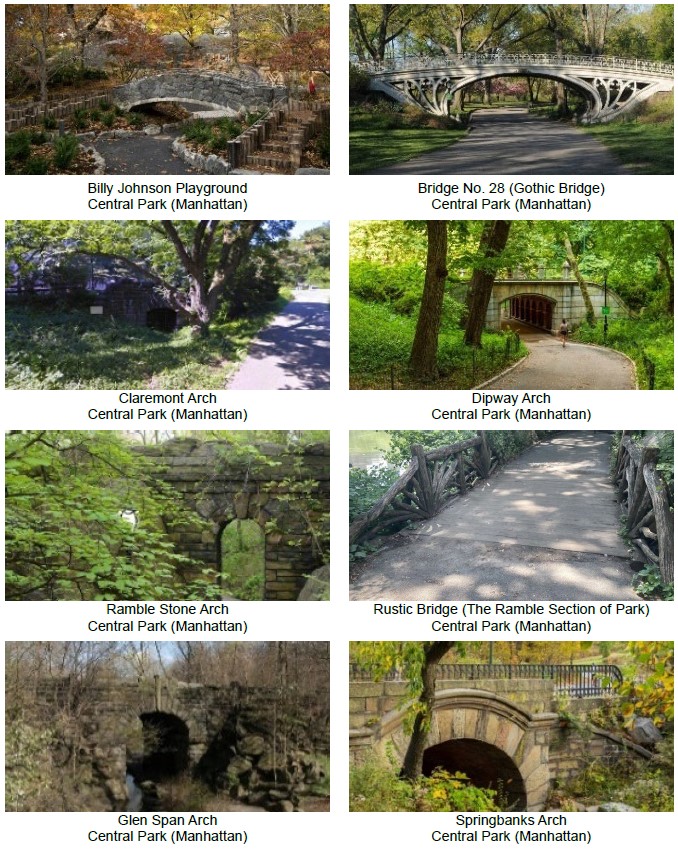
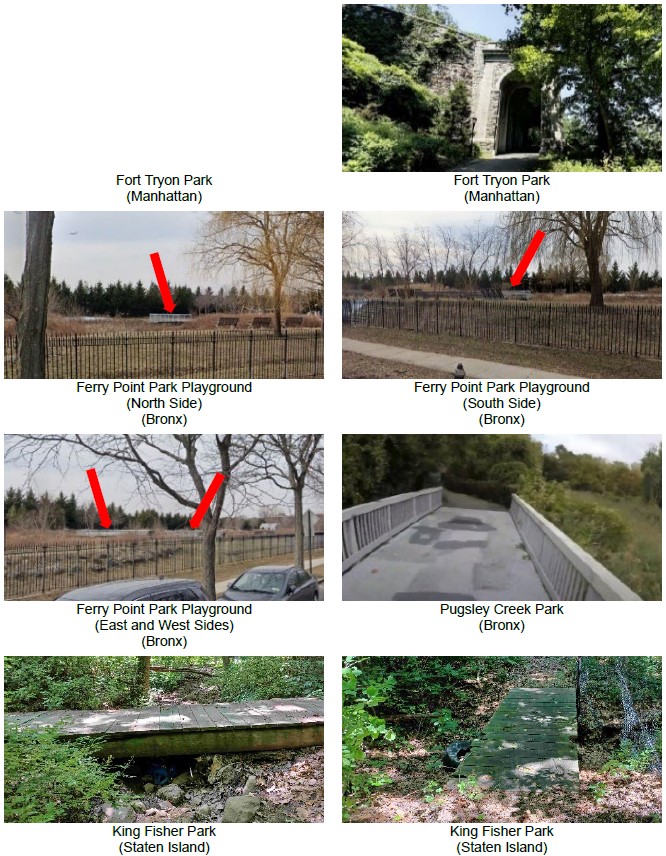
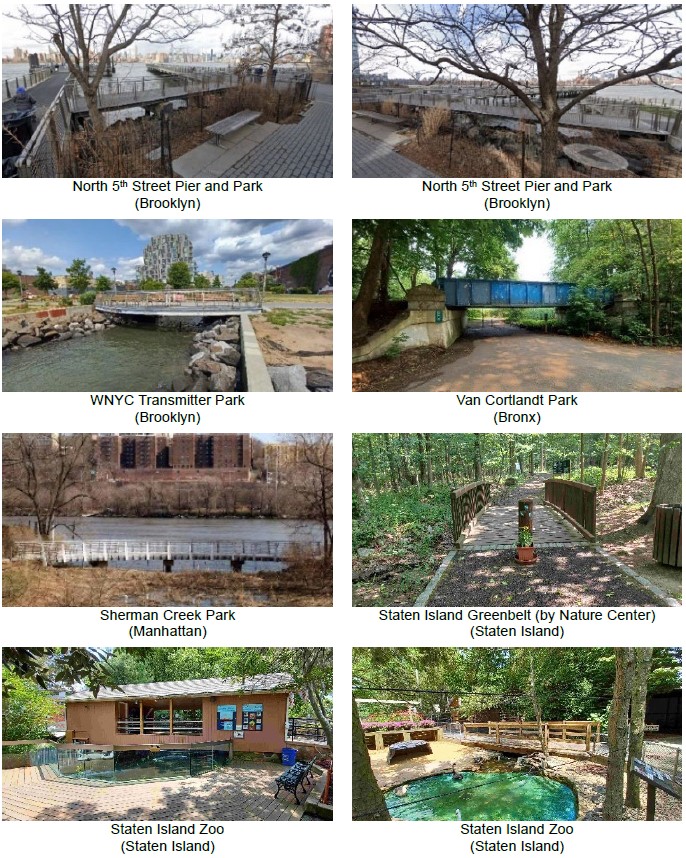
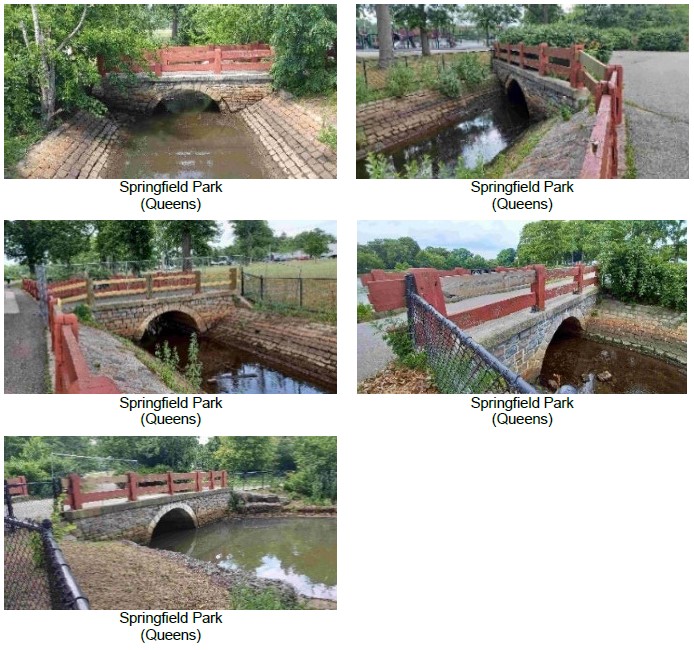
Appendix 2
Examples of the Observed Maintenance Deficiencies
Lemon Creek Park Pedestrian Bridge (BIN 2271650)
Staten Island (Photos by Auditors – June 2023)
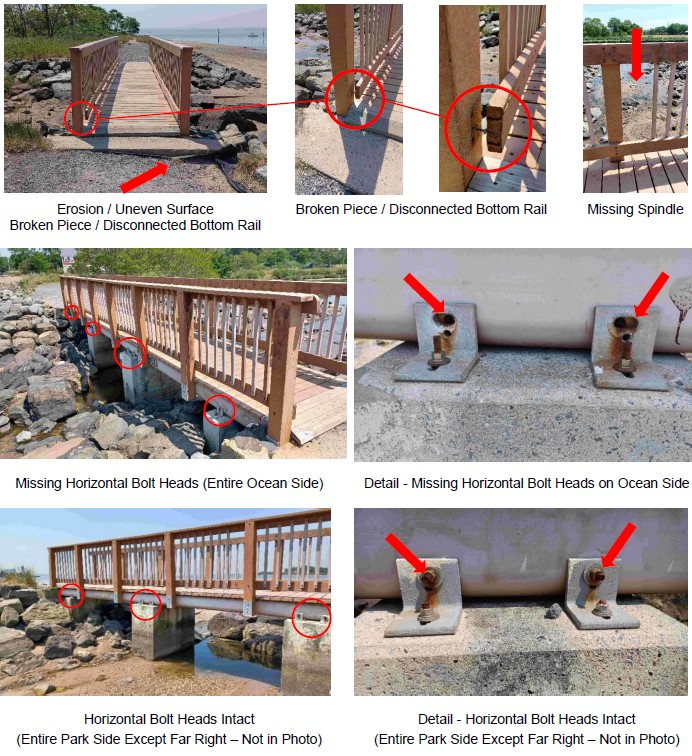
Vanderbilt Motor Parkway Bridge at 73rd Avenue (BIN 2248100)
Queens (Photos by Auditors – October 2022)

Appendix 3
Summary of Audit Observations at Sampled 86 Bridges (by Borough, Park Name)
|
# |
Park Name |
BIN |
Borough |
DPR’s Responsibilities | Additional Audit Observations and Comments (Comments in Bold refer to ADA and/or Safety Deficiencies Noted by Auditors) | ||||
| Excess Vegetation | Excess Debris | Peeling Paint | Clogged Drain | Damaged Fence | |||||
| 1 | Allerton Ballfields | 2241259 | Bronx | x | x | Corroded steel structure, graffiti and peeling paint. | |||
| 2 | Starlight Park* | 2241240 | Bronx | n/a | |||||
| 3 | Starlight Park* | 2269470 | Bronx | ||||||
| 4 | Starlight Park* | 2269480 | Bronx | n/a | Corroded guide rail. | ||||
| 5 | Starlight Park* | 2269900 | Bronx | n/a | |||||
| 6 | Van Cortlandt Park | 2229540 | Bronx | x | x | Wearing surface and deteriorated protective coating. | |||
| 7 | Van Cortlandt Park | 2229550 | Bronx | x | x | One timber railing is disconnected with tilted pole. | |||
|
8 |
Van Cortlandt Park |
2271600 |
Bronx |
x |
x |
Damaged fence, fence post with loose nails.
Plywood pieces added on top of bridge deck are creating a tripping hazard. Several wood planks are warped creating a tripping hazard. At the end of bridge deck at the concrete curb the level is uneven creating a tripping hazard. |
|||
| 9 | Van Cortlandt Park | 2271610 | Bronx | x | n/a | Cracked concrete, missing bolts and corroded surface. | |||
|
# |
Park Name |
BIN |
Borough |
DPR’s Responsibilities | Additional Audit Observations and Comments (Comments in Bold refer to ADA and/or Safety Deficiencies Noted by Auditors) | ||||
| Excess Vegetation | Excess Debris | Peeling Paint | Clogged Drain | Damaged Fence | |||||
| 10 | Prospect Park | 2244010 | Brooklyn | n/a | n/a | x | No BIN plate and transverse cracks. | ||
| 11 | Prospect Park | 2244020 | Brooklyn | x | n/a | Clogged catch basin, holes/detached fence. | |||
| 12 | Prospect Park | 2244030 | Brooklyn | x | n/a | x | Deteriorated/rotten timber planks. | ||
| 13 | Prospect Park | 2244040 | Brooklyn | x | n/a | x | Water accumulation and broken light fixture. | ||
| 14 | Prospect Park | 2244050 | Brooklyn | x | n/a | x | Broken chain link fence, efflorescence, and deteriorated pavement. | ||
| 15 | Prospect Park | 2244060 | Brooklyn | n/a | Spalls and longitudinal transverse cracks, efflorescence, discoloration, mold. | ||||
| 16 | Prospect Park | 2244070 | Brooklyn | x | n/a | x | Graffiti, soil run off/erosion, opening between the fence and parapet. | ||
|
17 |
Prospect Park |
2244090 |
Brooklyn |
x |
n/a |
n/a |
Wrong BIN Plate, obstructed waterway, and deteriorated/rotten timber beams.
Rotten wood plank with large hole – tripping hazard. |
||
|
18 |
Prospect Park |
2244100 |
Brooklyn |
n/a |
Deteriorated/rotten timber planks, fascia beam and railing. Wrong BIN on 155 Bridge List.
Missing Railing Sections creating a fall hazard. Raised bolt heads creating a tripping hazard. Exposed fastener threads creating a laceration hazard. |
||||
|
19 |
Prospect Park |
2244110 |
Brooklyn |
x |
n/a |
Damaged and missing railings, loose timber planks.
Uneven surface, bent nails – tripping hazard. |
|||
|
# |
Park Name |
BIN |
Borough |
DPR’s Responsibilities | Additional Audit Observations and Comments (Comments in Bold refer to ADA and/or Safety Deficiencies Noted by Auditors) | ||||
| Excess Vegetation | Excess Debris | Peeling Paint | Clogged Drain | Damaged Fence | |||||
| 20 | Prospect Park | 2244120 | Brooklyn | x | x | n/a | x | Wearing surfaces, efflorescence, and missing bricks. | |
| 21 | Prospect Park | 2244130 | Brooklyn | n/a | Bank protection is damaged and deteriorated mortar joints. | ||||
|
22 |
Prospect Park |
K-00001 |
Brooklyn |
x |
n/a |
Heavy efflorescence, wearing surface and no BIN plate.
Uneven surface – tripping hazard. |
|||
| 23 | Prospect Park | No BIN
assigned |
Brooklyn | x | n/a | n/a | Fallkill Bridge, less than 20 feet long. | ||
| 24 | Shore Road Park and Parkway | 2231250 | Brooklyn | x | x | Rust stains/heavy corrosion at the bottom of both sides of railing and cracked concrete slab. | |||
| 25 | Shore Road Park and Parkway | 2231260 | Brooklyn | x | x | Defective junction box, corroded railing and fencing, missing BIN plate and corroded girders. | |||
| 26 | Carl Schurz Park | 2271640 | Manhattan | x | n/a | n/a | Cracked pavement, heavy vegetation, and missing BIN plate. | ||
| 27 | Central Park | 2245420 | Manhattan | n/a | n/a | Efflorescence and underside of arch shows transverse cracks. | |||
| 28 | Central Park | 2246000 | Manhattan | x | Broken concrete railing, missing mortar and deteriorated façade bricks. | ||||
| 29 | Central Park | 2246080 | Manhattan | x | x | Spalled brickwork, eroded sandstone and efflorescence. | |||
| 30 | Central Park | 2246140 | Manhattan | x | n/a | x | n/a | Chipped/cracked stone blocks at wingwall and underside of Arch. | |
| 31 | Central Park | 2246160 | Manhattan | x | n/a | n/a | Plywood pieces on top of deck – not beveled – tripping hazard. | ||
| 32 | Central Park | 2246270 | Manhattan | x | x | x | Cracked and broken railing. | ||
|
# |
Park Name |
BIN |
Borough |
DPR’s Responsibilities | Additional Audit Observations and Comments (Comments in Bold refer to ADA and/or Safety Deficiencies Noted by Auditors) | ||||
| Excess Vegetation | Excess Debris | Peeling Paint | Clogged Drain | Damaged Fence | |||||
| 33 | Central Park | 2246280 | Manhattan | x | x | x | Cracked/broken railing and missing bolts. | ||
| 34 | Central Park | 2246320 | Manhattan | n/a | Spalled stone and missing mortar joints. | ||||
| 35 | Central Park | 2246360 | Manhattan | n/a | n/a | Efflorescence and spalled curb. | |||
| 36 | Central Park | 2246430 | Manhattan | x | n/a | n/a | Missing steel pipe railing and cracked asphalt. | ||
| 37 | Central Park | 2246470 | Manhattan | x | x | Temporary construction barriers present. | |||
|
38 |
East River Esplanade* |
2232120 |
Manhattan |
x |
x |
Major construction of a building above bridge in progress.
Original ADA ramp facing north on the river side was demolished due to current construction and temporary ADA ramp facing south installed. W ater marks and rust stain, corroded anchor bolts. |
|||
|
39 |
East River Esplanade / John Jay Park* |
2232140 |
Manhattan |
W ater leakage, cracked pavement and deteriorated joints.
Handrail on the street side is blocked by a section of fence. On the river side, one handrail fails to extend the required distance beyond the ramp run. The openings of drain gratings on the approaches to the ramps exceed the maximum allowance of 1/2 inch. Atop the bridge, projections from the fencing frame fall below the minimum clearance requirement of 80 inches for headroom. |
|||||
|
# |
Park Name |
BIN |
Borough |
DPR’s Responsibilities | Additional Audit Observations and Comments (Comments in Bold refer to ADA and/or Safety Deficiencies Noted by Auditors) | ||||
| Excess Vegetation | Excess Debris | Peeling Paint | Clogged Drain | Damaged Fence | |||||
|
40 |
East River Esplanade / John Finley W alk |
2232167 |
Manhattan |
Cracked/spalled parapet and uneven patches.
At multiple locations – uneven surface – tripping hazard. |
|||||
|
41 |
East River Esplanade / John Finley W alk* |
2269820 |
Manhattan |
Multiple handrail sections laying on the ground. posing a tripping hazard. Handrails fail to extend the required distance beyond the ramp runs. No edge protection on the river side of the ramp. |
|||||
|
42 |
East River Park |
2232050 |
Manhattan |
x |
x |
Tripping hazards – areas of spalled concrete and exposed buried electrical conduit, hole in walking surface on ramp.
Light poles missing handhole covers with exposed wiring. Debris and broken bottles on bridge. |
|||
|
43 |
East River Park* |
2233020 |
Manhattan |
x |
Underside of deck is rusted and decayed.
Handrails are not continuous (breaks at light poles). Clogged drains – possible water ponding and icing conditions. Light pole missing handhole cover with exposed electrical wires. Corroded electrical utility box – exposed electrical wires. |
||||
| 44 | Fort Tryon Park | 2245040 | Manhattan | n/a | n/a | Spalled concrete and spalls with and without exposed rebar, efflorescence/mold. | |||
| 45 | Fort Tryon Park | 2245050 | Manhattan | n/a | Efflorescence, underside with some cracks and patches. | ||||
| 46 | Fort Tryon Park | 2246500 | Manhattan | n/a | Spalled areas underside and cracked masonry stones. | ||||
|
# |
Park Name |
BIN |
Borough |
DPR’s Responsibilities | Additional Audit Observations and Comments (Comments in Bold refer to ADA and/or Safety Deficiencies Noted by Auditors) | ||||
| Excess Vegetation | Excess Debris | Peeling Paint | Clogged Drain | Damaged Fence | |||||
| 47 | Fort Tryon Park | 2246510 | Manhattan | x | n/a | x | n/a | Efflorescence, and cracked pavement. | |
|
48 |
Fort Washington Park |
2229400 |
Manhattan |
x |
x |
x |
Cracked surface, exposed aggregate, efflorescence at underdeck.
Tripping hazards – areas of spalled concrete. Clogged drains – possible water ponding and icing conditions. |
||
|
49 |
Fort Washington Park |
2245260 |
Manhattan |
x |
x |
x |
Detached and corroded chain link fence.
Tripping hazards – areas of spalled concrete. |
||
| 50 | Fort Washington Park | 7702990 | Manhattan | n/a | x | Exposed nails and deteriorated timber planks. | |||
| 51 | George Washington Bridge Park | 2246600 | Manhattan | Scaling with exposed aggregate, spalled concrete and graffiti. | |||||
| 52 | Inwood Hill Park | 2246690 | Manhattan | x | Wearing surface with cracks. | ||||
|
53 |
Inwood Hill Park |
2246700 |
Manhattan |
Cracks on wingwall and pavement.
Uneven surface – tripping hazard. Depressed area – subject to water ponding and icing conditions. |
|||||
|
54 |
Inwood Hill Park |
2245300 |
Manhattan |
x |
x |
Both fixed bearings at the end abutment show heavy corrosion.
Broken tread nosing – tripping hazard. |
|||
| 55 | Peter Detmold Park | 2232100 | Manhattan | x | x | Rust and paint loss, concrete cracks, and hanging electrical wire. | |||
| 56 | Riverside Park | 2271190 | Manhattan | * | * | * | * | * | The roof of the Amtrak Tunnel – Could Not Inspect. |
|
# |
Park Name |
BIN |
Borough |
DPR’s Responsibilities | Additional Audit Observations and Comments (Comments in Bold refer to ADA and/or Safety Deficiencies Noted by Auditors) | ||||
| Excess Vegetation | Excess Debris | Peeling Paint | Clogged Drain | Damaged Fence | |||||
| 57 | Twenty Four Sycamores Park | 2233040 | Manhattan | x | x | Concrete parapet with cracking and scaling, and exposed steel surface with corrosion. | |||
| 58 | Brookville Park | Q-00003 | Queens | x | Unstable railing posts and decayed/damaged railings. | ||||
| 59 | Brookville Park | Q-00004 | Queens | Missing/broken wingwall stones and decayed/damaged railings. | |||||
| 60 | Brookville Park | Q-00006 | Queens | x | n/a | n/a | The pavement with uneven surface, transverse cracks and settlement. | ||
| 61 | Brookville Park | Q-00008 | Queens | x | Missing cladding stones and efflorescence stains. | ||||
| 62 | Brookville Park | Q-00007 | Queens | x | x | The top railing has two loose sections and decayed/damaged railings. | |||
|
63 |
Crocheron Park |
2231880 |
Queens |
x |
x |
x |
One of the posts base grillage is rotten/deteriorated and has settled.
Tripping hazards – several exposed nail heads. |
||
|
64 |
Cross Island Parkway* |
2231890 |
Queens |
x |
Rotten planks.
Gaps in boards greater than 1/2 inch. Tripping hazards – several exposed nail heads. |
||||
|
65 |
Flushing Meadows Corona Park |
2248090 |
Queens |
x |
x |
Rust and erosion.
Missing covers on Light Poles – Exposed Electrical Wires. |
|||
| 66 | Flushing Meadows Corona Park | 2248130 | Queens | x | x | x | n/a | Rotten planks and gaps. | |
| 67 | Flushing Meadows Corona Park | 2248260 | Queens | x | Cracked and patched concrete, damaged railing. | ||||
|
# |
Park Name |
BIN |
Borough |
DPR’s Responsibilities | Additional Audit Observations and Comments (Comments in Bold refer to ADA and/or Safety Deficiencies Noted by Auditors) | ||||
| Excess Vegetation | Excess Debris | Peeling Paint | Clogged Drain | Damaged Fence | |||||
| 68 | Flushing Meadows Corona Park | 2248379 | Queens | x | n/a | Cracked asphalt, and spalled and patched pavement. | |||
|
69 |
Flushing Meadows Corona Park |
2270690 |
Queens |
n/a |
Cracked asphalt, and spalled and patched pavement.
Uneven, cracked surface – tripping hazard. |
||||
| 70 | Forest Park | 2247590 | Queens | x | Transverse and longitudinal cracks at pavement. | ||||
| 71 | Forest Park | 2247660 | Queens | x | x | n/a | x | n/a | Loose concrete, spalled with exposed rebars and cracks with efflorescence. |
| 72 | Forest Park | 2248340 | Queens | x | x | x | Exposed steel bottom flange of the floor beams and water ponding near midspan. | ||
| 73 | Highland Park | 2248280 | Queens | Cracks with efflorescence at underside of deck and cracked pavement. | |||||
|
74 |
Vanderbilt Motor Parkway /
Bell Boulevard |
2248060 |
Queens |
x |
x |
x |
n/a |
Corroded bolts, cracked pavement and spalled/cracked deck. | |
|
75 |
Vanderbilt Motor Parkway / Springfield Blvd. |
2248070 |
Queens |
n/a |
Efflorescence, peeling paint, wearing surface with cracks and exposed rebars. | ||||
|
76 |
Vanderbilt Motor Parkway /
Alley Pond Park |
2248110 |
Queens |
x |
Efflorescence and cracks at the mortar joints. |
||||
|
77 |
Vanderbilt Motor Parkway /
Alley Pond Park |
2271310 |
Queens |
x |
Efflorescence, peeling paint and missing light fixture under the deck. | ||||
| 78 | Clove Lakes Park | 2249710 | Staten Island | n/a | n/a | n/a | Cracks on wall with missing mortar, heavy efflorescence and cracked pavement. | ||
| 79 | Clove Lakes Park | 2249720 | Staten Island | n/a | n/a | n/a | Cracked pavement and parapet wall and heavy efflorescence. | ||
|
# |
Park Name |
BIN |
Borough |
DPR’s Responsibilities | Additional Audit Observations and Comments (Comments in Bold refer to ADA and/or Safety Deficiencies Noted by Auditors) | ||||
| Excess Vegetation | Excess Debris | Peeling Paint | Clogged Drain | Damaged Fence | |||||
| 80 | Clove Lakes Park | 2249730 | Staten Island | n/a | Heavy efflorescence, cracked and depressed pavement. | ||||
| 81 | Clove Lakes Park | 2249770 | Staten Island | n/a | Fallen trees/branches and wearing surface. | ||||
| 82 | Clove Lakes Park | 2249780 | Staten Island | x | n/a | n/a | n/a | Cracked pavement, missing mortar on the railing and patched concrete. | |
| 83 | Clove Lakes Park | 2249790 | Staten Island | x | x | n/a | Cracked pavement and mold on timber façade. | ||
| 84 | Clove Lakes Park | 2249800 | Staten Island | n/a | Minor spalls with scaling and cracks with efflorescence. | ||||
|
85 |
Lemon Creek Park* |
2271650 |
Staten Island |
n/a |
n/a |
n/a |
Significant elevation changes resulting from soil erosion are evident at both approaches, from the adjacent ground level to the bridge deck. Installed ramped pieces on the ends of the bridge, on both sides, do not meet ADA ramp or change in elevation requirements. The above conditions also create tripping hazards. Missing a spindle at railing. Broken piece with exposed metal screws. |
||
| 86 | W olfe’s Pond Park* | S-00001 | Staten Island | New bridge, first inspection, no BIN plate. | |||||
| Total Number of Applicable Bridges | 80 | 80 | 57 | 69 | 50 |
| Number of Maintenance Deficiencies | 33 | 12 | 21 | 18 | 8 |
| Maintenance Deficiencies (%) | 41% | 15% | 37% | 26% | 16% |
Legend:
* Bridge was built or underwent a major rehabilitation after 1991, thus requiring compliance with ADA Standards
Appendix 4
DPR’s Request for Expense Funding to OMB
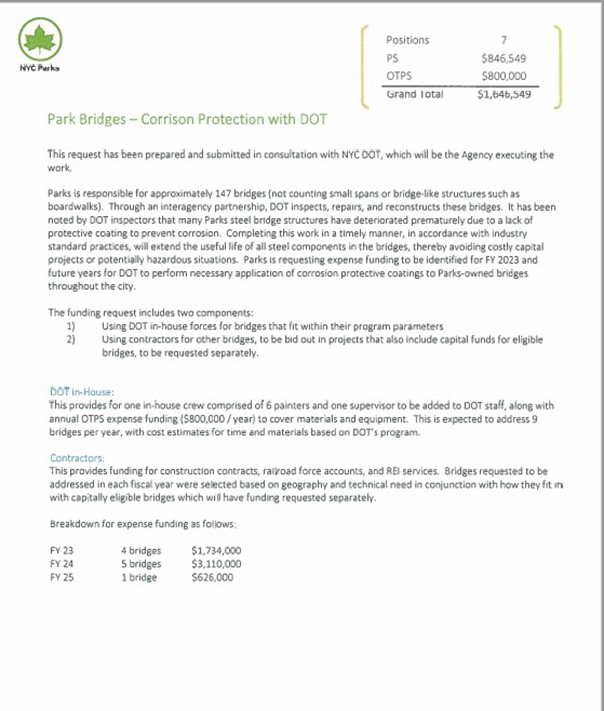
Appendix 5
Status of Outstanding Maintenance and Repairs
|
# |
Park/Bridge Name (BIN #) |
Borough |
Last DOT Flag Report Received |
Open CMR / Flag # |
Condition Reported |
DOT Flag # |
Open/Close d |
Explanation from DOT |
|
1 |
Van Cortlandt Park (2229540) |
Bronx |
2022 (Biennial) |
CMR #18-531 | Missing electrical utility box door and exposed electrical wires. | 40334 | Open | Routed to Lighting on 7/15/2013. |
| CMR #18-532 | Deteriorated paint on the superstructure. | 47747 | Open | Routed to DOT When and Where Unit on
9/1/2022. |
||||
|
CMR #19-465 |
Vegetation grown on top of the bridge. |
44317 |
Open |
Routed on 7/28/2016- Parks M&O continually clears vegetation as part of the operation. Heavily utilized areas are
prioritized over trails. |
||||
|
2 |
Vanderbilt Motor Parkway / Alley Pond Park (2248110) |
Bronx |
2022 (Interim) |
CMR #20-158 | Deteriorated paint. | Condition found not warranted a Flag. | ||
| CMR #19-373 | Eroded end approach right side shoulder and top of the slopped area. | 37966 | Closed | Closed per DOT Insp. Email dated
6/12/20. |
||||
|
3 |
Van Cortlandt Park / Golf Course Bridge (2271600) |
Bronx |
2022 (Biennial) |
CMR #20-322 | Holes at chain link fence of spans. | 51267 | Open | In process of being completed. |
|
CMR #20-324 |
Erosion at end approach right side. |
51270 |
Open |
Currently routed to DPR. Needs to be rerouted to DOT When and Where Unit. | ||||
| CMR #20-334 | Missing BIN plate. | 51287 | Open | Currently routed to DPR. Needs to be
rerouted to DOT. |
||||
| CMR #20-323 | Heavy accumulation of silt and debris at spans. | 51252 | Open | In process of being completed. | ||||
|
4 |
Shore Road Park and Parkway (2231250) |
Brooklyn |
2022 (Biennial) |
CMR #19-125 | BIN plate painted over. | 45630 | Open | Currently routed to DPR. Needs to be
rerouted to DOT. |
| CMR #20-155 | Heavily rusted railing and fence. | 47436, 47638,
50441 |
Open | Routed to DOT When and Where Unit. | ||||
| CMR #19-139 | Crack and hollow sounding area at pier 2. | 48542 | Closed | Work completed on 8/11/23. | ||||
| CMR #19-150 | Corrosion and paint loss at girders & diaphragms. | Condition found not warranted a Flag. | ||||||
| CMR #19-393 | Settlement and crack at begin approach. | 49292 | Closed | Work completed on 8/8/23. |
|
# |
Park/Bridge Name (BIN #) |
Borough |
Last DOT Flag Report Received |
Open CMR / Flag # |
Condition Reported |
DOT Flag # |
Open/Close d |
Explanation from DOT |
|
5 |
Shore Road Park and Parkway (2231260) |
Brooklyn |
2022 (Interim) |
CMR #19-442 | Missing BIN plate. | 49323 | Closed | Work completed on 8/11/23. |
| CMR #19-461 | Corroded railing and fence frame. | 46350, 46351 | Open | Needs to be rerouted to DOT When and
Where Unit. |
||||
| Yellow Flag #I20-049 | Girders exhibit thru hole & section loss. | 50963 | Open | Needs to be rerouted to DOT When and
Where Unit. |
||||
| 6 | Calvert Vaux Park (2231330) | Brooklyn | 2022
(Biennial) |
CMR #18-630 | Corrosion of mid-span expansion joint. | 47932 | Open | Pending closure, bridge is under Capital contract. |
|
7 |
Prospect Park / Eastwood Arch (2244040) |
Brooklyn |
2022 (Biennial) |
CMR #18-397 | Water and mud accumulation on the bridge. | 40335 | Closed | DOT Insp. Removed 8/5/21. |
| CMR #19-395 | Non-functioning lighting fixtures. | 49113 | Open | Currently routed to DPR. Needs to be
rerouted to DOT (Lighting). |
||||
| CMR #19-404 | Missing mortar. | 45099 | Closed | Work completed 8/11/23. | ||||
| CMR #19-595 | Rotten railing posts on the right side of the bridge. | 49676 | Closed | Work completed 7/20/20. | ||||
| CMR #20-057 | Hollow sounded and loose stones. | Open | Will be Routed to DOT When and Where
Unit. |
|||||
|
8 |
Prospect Park / Music Grove Bridge (2244100) |
Brooklyn |
2021 (Biennial) |
CMR #17-430 | BIN plate cannot be found on the bridge. | 42854 | Closed | Work completed 8/7/23. |
| CMR #20-248 | Deteriorated and missing timber railing. | 50931 | Open | Routed to DOT When and Where Unit. | ||||
| CMR #18-306 | Deteriorated / loose railing. | 47187 | open | Needs to be rerouted to DOT When and
Where Unit. |
||||
|
9 |
Peter Detmold Park (2232100) |
Manhattan |
2022 (Interim) |
CMR #18-426 | Clogged scupper. | 44633, 45894 | Open | In process of being completed |
| CMR #18-428 | Deteriorated paint. | 40163 | Open | Awaiting approval of funding from OMB
for DOT to perform work. |
||||
| CMR #19-322 | Rusted bearings. | 46271 | Open | Needs to be rerouted to DOT When and
Where Unit. |
||||
| CMR #19-337 | Rust on steel staircases. | 36192, 40163 | Open | Awaiting approval of funding from OMB
for DOT to perform work. |
||||
| CMR #20-183 | Cracked concrete encased beam. | 44635 | Open | Needs to be rerouted to DOT When and
Where Unit. |
|
# |
Park/Bridge Name (BIN #) |
Borough |
Last DOT Flag Report Received |
Open CMR / Flag # |
Condition Reported |
DOT Flag # |
Open/Close d |
Explanation from DOT |
|
10 |
East River Esplanade (2231330) |
Manhattan |
2020 (Interim) |
CMR #20-011 | BIN plate is not readable. | 50067 | Open | In process of being completed. |
|
Yellow Flag #I20-043 |
Severely corroded nut, bolt and washers of pin at both abutment’s bearing. |
51004 |
Open |
In process of being completed. |
||||
|
11 |
East River Park / East 10th Street & FDR (2233020) |
Manhattan |
2021 (Biennial) |
CMR #19-347 |
Displaced jersey barrier. |
49076 |
Open |
Routed to DOT When and Where Unit on 5/17/2022 (NYC Flag #45579 was a duplicate, closed on 8/17/23). |
| CMR #19-345 | Damaged lighting fixtures. | 48990 | Open | Routed to Lighting on 7/15/2019. | ||||
| CMR #18-258 | Cracked concrete encasement at the base of Pier 12. | 47112 | Open | Routed to DOT When and Where Unit on 5/17/2022. | ||||
| CMR #20-242 | Missing hand hole cover or light standard at span 4. | 37515 | Open | CMR not in the scope. CMR 18-256 NYC
Flag #37515. |
||||
| CMR #18-249 | Corroded under side of utility box with section loss and exposed wiring. | 44176 | Open | Routed to Lighting on 6/10/2016. | ||||
|
CMR #18-248 |
Missing lights at sign structure. |
– |
No flag condition. Per DOT – Lighting, light at sign is not needed due to reflective signs. | |||||
| CMR #18-214 | Clogged scupper in spans 4, 10, 20. | 47043 | Open | Routed to DOT When and Where Unit
on 5/17/2022. |
||||
|
12 |
East River Park / East 6th Street & FDR (2232050) |
Manhattan |
2022 (Interim) |
CMR #17-291 | Deteriorated concrete deck. | 45777 | Open | Routed to DOT When and Where Unit. |
| CMR #18-244 | Non-functioning lights and open or loose cover electrical junction box. | 44307 | Open | Routed to Lighting. | ||||
| CMR #20-044 | Open electrical junction boxes. | 39192 | Open | Routed to Lighting. | ||||
| CMR #20-087 | Pigeon droppings. | 50228 | Open | Needs to be rerouted to DOT When and
Where Unit. |
||||
|
13 |
George Washington Bridge Park (2246600) |
Manhattan |
2022 (Biennial) |
CMR #18-141 | Exposed aggregates and rebar of
concrete under deck. |
46926 | Closed | Work completed 6/16/23. |
| CMR #19-529 | Missing window guards. | 42553 | Open | Needs to be rerouted to DOT When and
Where Unit. |
|
# |
Park/Bridge Name (BIN #) |
Borough |
Last DOT Flag Report Received |
Open CMR / Flag # |
Condition Reported |
DOT Flag # |
Open/Close d |
Explanation from DOT |
|
14 |
Crocheron Park (2231880) |
Queens |
2022 (Biennial) |
CMR #19-026 | Unlocked door. | 48246 | Open | Currently routed to DPR. Will be rerouted
to DOT. |
| CMR #20-238 | Deteriorated steel member protective coating at spans 1 & 2. | 50815 | Open | Currently routed to DPR. Will be rerouted
to DOT. |
||||
|
15 |
Cross Island Parkway (2231890) |
Queens |
2022 (Biennial) |
CMR #21-126 | Disconnected/missing & loose wooden cross bracing. | 51899 | Open | Routed to DOT When and Where Unit. |
| CMR #21-190 | Cracked pier cap beams. | 52201 | Open | Routed to DOT When and Where Unit. | ||||
| Yellow Flag #I21-028 | Split timber pier pedestals. | 34971 | Closed | Work completed 2/27/23. | ||||
| CMR #19-281 | Missing BIN plate. | 43210 | Open | Routed to DOT When and Where Unit. | ||||
|
16 |
Flushing Meadows Corona Park / Meadow Lake (2248260) |
Queens |
2022 (By NYS DOT) | Yellow Flag NB22VQW005 | Deteriorations of reinforced concrete pile 2 cap beam. | 43205 | Open | Routed to DOT When and Where Unit. |
| Yellow Flag NB22VQW006 | Deteriorations of reinforced concrete pile 2 cap beam. | 33410 | Open | Routed to DOT When and Where Unit. | ||||
|
17 |
Brookville Park (Q-00003) |
Queens |
2021 (Interim) |
CMR #20-335 | No BIN plate. | 51404 | Open | Routed to DOT When and Where Unit
on 1/5/2023. |
| CMR #20-363 | Unstable railing posts. | 51431 | Closed | Closed on 1/24/2023. | ||||
| CMR #20-364 | Loose deck planks and deteriorated
timber support beam. |
51432 | Closed | Closed on 1/20/2023. | ||||
|
18 |
Clove Lakes Park / West Footbridge (2249710) |
Staten Island |
2021 (Biennial) |
CMR #18-297 |
Cracks, spalls, and uneven wearing surface. | 53907
(prev. 36651) |
Open |
Parks and DOT are working to coordinate the paving repairs with the current Parks Clove Lake paving project. |
| CMR #18-309 | Cracks on spandrel wall & missing mortar on approach parapet wall. | 31306 | Open | Routed to DOT When and Where Unit
on 2/21/2023. |
||||
| CMR #20-278 | Missing bolts at the corrugated metal arch lining. | 51034 | Closed | Closed on 5/5/2022. | ||||
| 19 | Clove Lakes Park (2249790) | Staten Island | 2020
(Biennial) |
CMR #18-007 | Tree trunk in the stream. | 46658 | Closed | Removed by DOT Insp. 11/30/22. |
Appendix 6
Photos – Examples of ADA Compliance and Safety Issues
ADA Compliance Issues
East 81st Street Pedestrian Bridge (BIN# 2269820) East River Esplanade / John Finley Walk Manhattan (Photos by Auditors – October 2022)
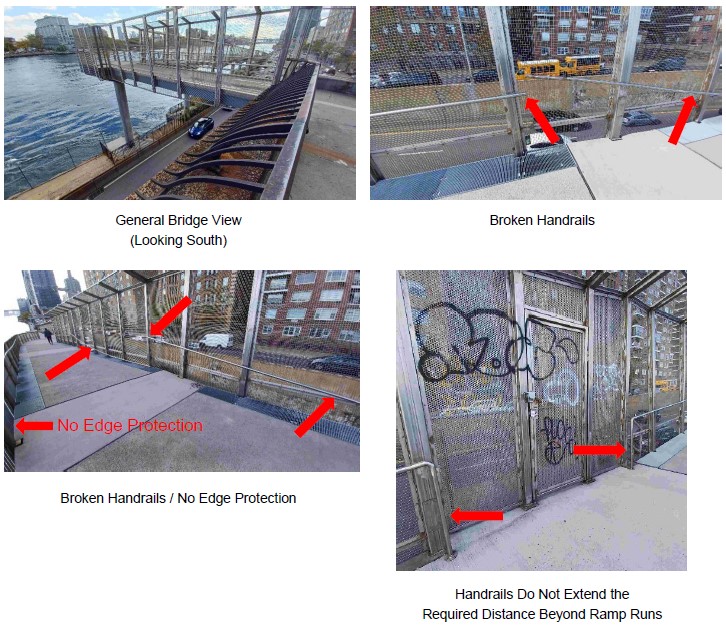
ADA Compliance Issues
East 78th Street Pedestrian Bridge (BIN# 2232140) East River Esplanade / John Jay Park
Manhattan
(Photos by Auditors – October 2022)

ADA Compliance Issue
Tidal Marsh Bridge (No BIN)
Marine Park, Brooklyn
(Photos by Auditors – September 2023)
Per DPR Website, the Hiking Trails in Marine Park are Listed as ADA Accessible
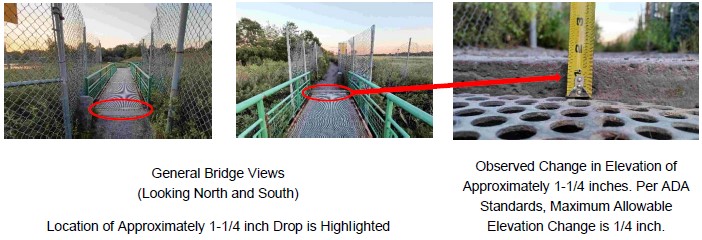
Safety Issues
East 6th Street Pedestrian Bridge (BIN# 2232050)
East River Park, Manhattan
(Photos by Auditors – October 2022)
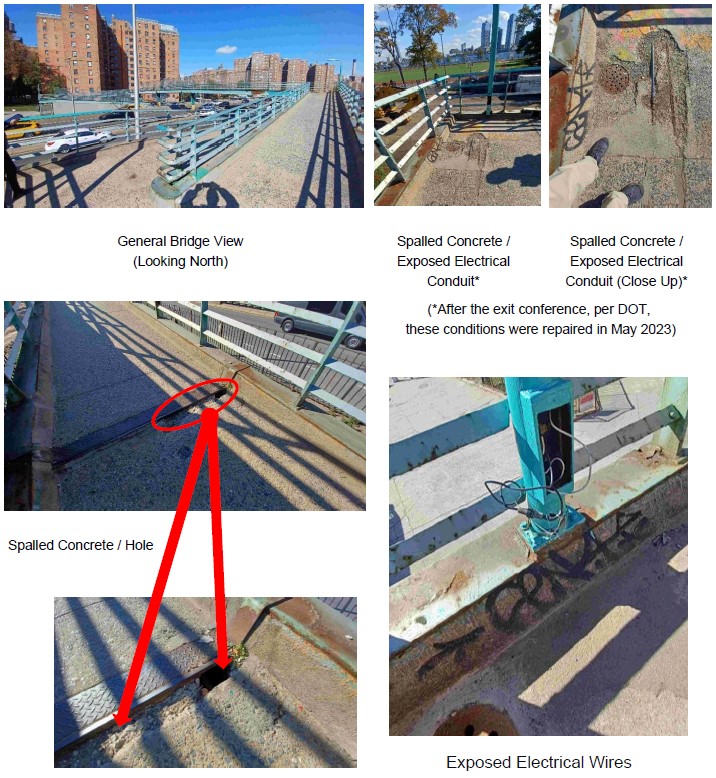
Appendix 7
Summary of ADA Accessibility Status
| NYC Parks (DPR) | Department of City Planning (DCP) | Auditors’ Determination | |||||
|
# |
Bridge Identification Number (BIN)* |
Park Name (with Bridge Name per NYC Parks) |
Community District Number and Borough |
Household Income (See Note 1) |
Accessibility to Parks
(per DCP Community District Data) (See Note 2) |
ADA Accessibility |
Auditors’ Comments |
|
1 |
2241259* |
Allerton Ballfields |
CD 7 (Bronx) |
$25,000-$40,000 |
83% |
Yes |
Bridge was built in 1904 before ADA requirements. Appears to meet basic ADA requirements.** |
|
2 |
2231300 |
Bath Beach Park |
CD 11 (Brooklyn) |
> $55,000-$70,000 |
59% |
In-Process |
Original bridge built in 1941 was demolished.
New ADA accessible bridge in construction. Estimated completion in 2024. |
|
3 |
2231330* |
Calvert Vaux Park |
CD 13 (Brooklyn) |
> $40,000-$55,000 |
77% |
No |
Original bridge built in 1941 will be demolished.
Existing Bridge has steps – Does not meet current ADA Standards. New ADA accessible bridge in construction. Estimated completion in 2024. |
|
4 |
2232029* |
Corlears Hook Park |
CD 3 (Manhattan) |
> $40,000-$55,000 |
99% |
In-Process |
Original bridge built in 1955 was demolished. New ADA accessible bridge in construction. Estimated completion date unknown. |
|
5 |
2231880* |
Crocheron Park |
CD 11 (Queens) |
> $70,000-$100,000 |
65% |
No |
Bridge was built in 1941 before ADA requirements. Bridge has steps – Does not meet current ADA Standards. |
|
6 |
2231890* |
Cross Island Parkway |
CD 11 (Queens) |
> $70,000-$100,000 |
65% |
Yes |
Bridge was built in 1941 before ADA requirements. The bridge has ADA-compliant ramps. Appears to meet basic ADA requirements. |
|
7 |
No BIN |
East Midtown Greenway / Sutton Place |
CD 6 (Manhattan) |
> $100,000-$200,000 |
79% |
Yes |
New ADA accessible bridge in construction nearing completion. |
| NYC Parks (DPR) | Department of City Planning (DCP) | Auditors’ Determination | |||||
|
# |
Bridge Identification Number (BIN)* |
Park Name (with Bridge Name per NYC Parks) |
Community District Number and Borough |
Household Income (See Note 1) |
Accessibility to Parks
(per DCP Community District Data) (See Note 2) |
ADA Accessibility |
Auditors’ Comments |
|
8 |
2232120* |
East River Esplanade |
CD 8 (Manhattan) |
> $100,000-$200,000 |
94% |
Yes |
Bridge was built in 1993.
Major construction of a building above bridge in progress. Original ADA ramp facing north on the river side was demolished due to current construction and temporary ADA ramp facing south installed. |
|
9 |
2232200 |
East River Esplanade |
CD 11 (Manhattan) |
$25,000-$40,000 |
99% |
No |
Bridge was built in 1949 before ADA requirements. Audit inspection not conducted.
Existing ramps do not meet current ADA Standards. |
|
10 |
2269820* |
East River Esplanade / John Finley Walk |
CD 8 (Manhattan) |
> $100,000-$200,000 |
94% |
Yes |
Original bridge built in 1942 was replaced in 2017. Appears to meet basic ADA requirements. |
|
11 |
2232140* |
East River Esplanade / John Jay Park |
CD 8 (Manhattan) |
> $100,000-$200,000 |
94% |
Yes |
Original bridge built in 1940 was replaced in 2012. Appears to meet basic ADA requirements. |
|
12 |
2232030* |
East River Park |
CD 3 (Manhattan) |
> $40,000-$55,000 |
99% |
In-Process |
Original bridge built in 1955 was demolished. New bridge is planned. |
|
13 |
2232050* |
East River Park |
CD 3 (Manhattan) |
> $40,000-$55,000 |
99% |
No |
Original bridge built in 1953 underwent a major rehabilitation in 1998. Existing ramps do not comply with current ADA Standards. |
|
14 |
2233020* |
East River Park |
CD 3 (Manhattan) |
> $40,000-$55,000 |
99% |
Yes |
Original bridge built in 1953 underwent a major rehabilitation in 2003. Appears to meet basic ADA requirements. |
|
15 |
No BIN |
Flushing Meadows Corona Park (Passerelle Bridge) | CD 3 (Queens)
CD 4 (Queens) CD 7 (Queens) |
> $55,000-$70,000
> $55,000-$70,000 > $55,000-$70,000 |
60%
62% 73% |
Yes |
Bridge was built in 1964 before ADA requirements. Appears to meet basic ADA requirements. |
|
16 |
2248379* |
Flushing Meadows Corona Park (FMCP Boathouse Bridge) |
CD 6 (Queens) CD 8 (Queens) |
> $70,000-$100,000 > $70,000-$100,000 |
68% 58% |
Yes |
Bridge was built in 1960 before ADA requirements. Appears to meet basic ADA requirements. |
| NYC Parks (DPR) | Department of City Planning (DCP) | Auditors’ Determination | |||||
|
# |
Bridge Identification Number (BIN)* |
Park Name (with Bridge Name per NYC Parks) |
Community District Number and Borough |
Household Income (See Note 1) |
Accessibility to Parks
(per DCP Community District Data) (See Note 2) |
ADA Accessibility |
Auditors’ Comments |
|
17 |
2248260* |
Flushing Meadows Corona Park (FMCP Meadow Lake Drive Bridge S) |
CD 6 (Queens) CD 8 (Queens) |
> $70,000-$100,000 > $70,000-$100,000 |
68% 58% |
No |
Bridge was built in 1960 before ADA requirements. The bridge does not have steps or ramps and possibly would meet current ADA requirements, except per Auditors’ observations and opinion:
– Sidewalks are too narrow for wheelchair access. |
|
18 |
2229400* |
Fort Washington Park |
CD 12 (Manhattan) |
> $55,000-$70,000 |
100% |
No |
Bridge was built in 1955 before ADA requirements. Existing ramp does not comply with current ADA Standards. |
|
19 |
2245260* |
Fort Washington Park |
CD 12 (Manhattan) |
> $55,000-$70,000 |
100% |
No |
Bridge was built in 1930. Bridge rehabilitation performed in 2000. However, the bridge still does not meet current ADA Standards. Bridge has steps. |
|
20 |
2271590 |
Fort Washington Park |
CD 12 (Manhattan) |
> $55,000-$70,000 |
100% |
Yes |
Bridge was built between 1996-2002 (Estimated). Appears to meet basic ADA requirements. |
|
21 |
7702990* |
Fort Washington Park (181st Amtrak Bridge) |
CD 12 (Manhattan) |
> $55,000-$70,000 |
100% |
Yes |
Bridge was built in 1928. Bridge rehabilitation was performed in 1939, before ADA requirements. Appears to meet basic ADA requirements. |
|
22 |
2271510 |
Freshkills Park |
CD 3 (Staten Island) |
> $100,000-$200,000 |
54% |
In-Process |
New ADA compliant bridge planned. |
|
23 |
2246600* |
George Washington Bridge Park |
CD 12 (Manhattan) |
> $55,000-$70,000 |
100% |
No |
Bridge built in 1933 before ADA requirements. Existing ramp does not meet current ADA Standards. |
|
24 |
2246990 |
Harlem River Park |
CD 11 (Manhattan) |
$25,000-$40,000 |
99% |
No |
Bridge built in 1950 before ADA requirements. Audit inspection not conducted.
Bridge has steps – Does not meet current ADA Standards. |
|
25 |
2246580 |
High Bridge Park |
CD 12 (Manhattan) CD 4 (Bronx) |
> $55,000-$70,000 $25,000-$40,000 |
100% 93% |
Yes |
Original bridge was built in 1848 and underwent a major rehabilitation in 2015.
Audit inspection not conducted. Per DPR website and other sources, this bridge is ADA Accessible. |
| NYC Parks (DPR) | Department of City Planning (DCP) | Auditors’ Determination | |||||
|
# |
Bridge Identification Number (BIN)* |
Park Name (with Bridge Name per NYC Parks) |
Community District Number and Borough |
Household Income (See Note 1) |
Accessibility to Parks
(per DCP Community District Data) (See Note 2) |
ADA Accessibility |
Auditors’ Comments |
|
26 |
2245300* |
Inwood Hill Park |
CD 12 (Manhattan) |
> $55,000-$70,000 |
100% |
No |
Bridge was built in 1938 before ADA requirements. Bridge has steps – Does not meet current ADA Standards. |
|
27 |
2242120 |
New York Botanical Garden |
CD 6 (Bronx)
CD 7 (Bronx) CD 11 (Bronx) CD 12 (Bronx) |
$25,000-$40,000
$25,000-$40,000 > $55,000-$70,000 > $55,000-$70,000 |
77%
83% 73% 51% |
Yes |
Bridge was built in 1920 before ADA requirements. Appears to meet basic ADA requirements. |
|
28 |
2242210 |
New York Botanical Garden |
CD 6 (Bronx)
CD 7 (Bronx) CD 11 (Bronx) CD 12 (Bronx) |
$25,000-$40,000
$25,000-$40,000 > $55,000-$70,000 > $55,000-$70,000 |
77%
83% 73% 51% |
Yes |
Bridge was built in 1951 before ADA requirements. Appears to meet basic ADA requirements. |
|
29 |
2242220 |
New York Botanical Garden |
CD 6 (Bronx)
CD 7 (Bronx) CD 11 (Bronx) CD 12 (Bronx) |
$25,000-$40,000
$25,000-$40,000 > $55,000-$70,000 > $55,000-$70,000 |
77%
83% 73% 51% |
Yes |
Bridge was built in 1920 before ADA requirements. Appears to meet basic ADA requirements. |
|
30 |
2232100* |
Peter Detmold Park |
CD 6 (Manhattan) |
> $100,000-$200,000 |
79% |
No |
Bridge was built in 1952 before ADA requirements. Bridge has steps – Does not meet current ADA Standards. |
|
31 |
2270970 |
Randall’s Island Park |
CD 11 (Manhattan) CD 1 (Bronx) |
$25,000-$40,000 $25,000-$40,000 |
99% 93% |
Yes |
Bridge was built in 2009 and rehabilitated in 2015. Appears to meet basic ADA requirements. |
|
32 |
2245230 |
River State Park |
CD 9 (Manhattan) |
> $55,000-$70,000 |
100% |
No |
Bridge was built in 1940. Bridge rehabilitation performed in 2009. However, the bridge still does not meet current ADA Standards. Bridge has steps. |
|
33 |
222928C* |
Riverside Park |
CD 7 (Manhattan) |
> $100,000-$200,000 |
99% |
No |
Bridge was built in 1937 before ADA requirements.
Bridge has steps – Does not meet current ADA Standards. Alternate side approach – sloped, but grade exceeds maximum slope allowed by ADA Standards. |
|
34 |
2271280 |
Riverside Park |
CD 9 (Manhattan) |
> $55,000-$70,000 |
100% |
Yes |
New bridge built in 2018. Appears to meet basic ADA requirements. |
| NYC Parks (DPR) | Department of City Planning (DCP) | Auditors’ Determination | |||||
|
# |
Bridge Identification Number (BIN)* |
Park Name (with Bridge Name per NYC Parks) |
Community District Number and Borough |
Household Income (See Note 1) |
Accessibility to Parks
(per DCP Community District Data) (See Note 2) |
ADA Accessibility |
Auditors’ Comments |
|
35 |
2231250* |
Shore Road Park and Parkway |
CD 10 (Brooklyn) |
> $70,000-$100,000 |
69% |
No |
Bridge was built in 1941 before ADA requirements. Bridge has steps – Does not meet current ADA Standards. |
|
36 |
2231260* |
Shore Road Park and Parkway |
CD 10 (Brooklyn) |
> $70,000-$100,000 |
69% |
No |
Bridge was built in 1941 before ADA requirements. Bridge has steps – Does not meet current ADA Standards. |
|
37 |
2269900* |
Starlight Park (Starlight Bridge 1) |
CD 3 (Bronx)
CD 6 (Bronx) CD 9 (Bronx) |
$25,000-$40,000
$25,000-$40,000 > $40,000-$55,000 |
80%
77% 81% |
Yes |
New bridge built in 2021/2022 (estimated). Appears to meet basic ADA requirements. |
|
38 |
2241240* |
Starlight Park (Starlight Bridge 2) |
CD 3 (Bronx)
CD 6 (Bronx) CD 9 (Bronx) |
$25,000-$40,000
$25,000-$40,000 > $40,000-$55,000 |
80%
77% 81% |
Yes |
New bridge built in 2021/2022 (estimated). Appears to meet basic ADA requirements. |
|
39 |
2269470* |
Starlight Park (Starlight Bridge 3) |
CD 3 (Bronx)
CD 6 (Bronx) CD 9 (Bronx) |
$25,000-$40,000
$25,000-$40,000 > $40,000-$55,000 |
80%
77% 81% |
Yes |
New bridge built in 2020. Appears to meet basic ADA requirements. |
|
40 |
2269480* |
Starlight Park (Starlight Bridge 4) |
CD 3 (Bronx)
CD 6 (Bronx) CD 9 (Bronx) |
$25,000-$40,000
$25,000-$40,000 > $40,000-$55,000 |
80%
77% 81% |
Yes |
Bridge was built in 2012. Appears to meet basic ADA requirements. |
|
41 |
2232190 |
Thomas Jefferson Park |
CD 11 (Manhattan) |
$25,000-$40,000 |
99% |
No |
Bridge was built in 1949 before ADA requirements. Audit inspection not conducted.
Existing ramps do not meet current ADA Standards. |
|
42 |
2233040* |
Twenty Four Sycamores Park |
CD 8 (Manhattan) |
> $100,000-$200,000 |
94% |
Yes |
Bridge was built in 1941 before ADA requirements. Appears to meet basic ADA requirements. |
|
43 |
2229540* |
Van Cortlandt Park |
CD 7 (Bronx)
CD 8 (Bronx) CD 12 (Bronx) |
$25,000-$40,000
> $55,000-$70,000 > $55,000-$70,000 |
83%
87% 51% |
Yes |
Bridge was built in 1937 before ADA requirements. Appears to meet basic ADA requirements. |
| NYC Parks (DPR) | Department of City Planning (DCP) | Auditors’ Determination | |||||
|
# |
Bridge Identification Number (BIN)* |
Park Name (with Bridge Name per NYC Parks) |
Community District Number and Borough |
Household Income (See Note 1) |
Accessibility to Parks
(per DCP Community District Data) (See Note 2) |
ADA Accessibility |
Auditors’ Comments |
| 44 | 2229550* | Van Cortlandt Park | CD 7 (Bronx)
CD 8 (Bronx) CD 12 (Bronx) |
$25,000-$40,000
> $55,000-$70,000 > $55,000-$70,000 |
83%
87% 51% |
Yes | Bridge was built in 1937 before ADA requirements. Appears to meet basic ADA requirements. |
| 45 | No BIN* | Van Cortlandt Park | CD 7 (Bronx)
CD 8 (Bronx) CD 12 (Bronx) |
$25,000-$40,000
> $55,000-$70,000 > $55,000-$70,000 |
83%
87% 51% |
In-Process | Planned new bridge project was canceled. |
|
|
“ADA Accessibility” Yes 24 No 16 In-Process 5 |
Bridge in Design / Under Construction / Not Completed [See Auditors’ Comments for explanation] | |||||
Legend
* Indicates that this location was visited by Auditors
** Appears to meet basic ADA requirements refers to bridge having a clear path, level surface (no steps) and if a ramp is present, it is not steeper than 1:12 (i.e., 1 inch rise for 12 inches of horizontal distance)
Note 1
Household Income data maintained by NYC Department of City Planning (DCP), which used data from the 2020 Census, American Community Survey (ACS)
Note 2
According to DCP, “Access to Parks” statistics were obtained from DPR’s 2016 data. DPR considers walking distance to be 1/4 mile for parks less than 6 acres, and 1/2 mile for larger parks and pools
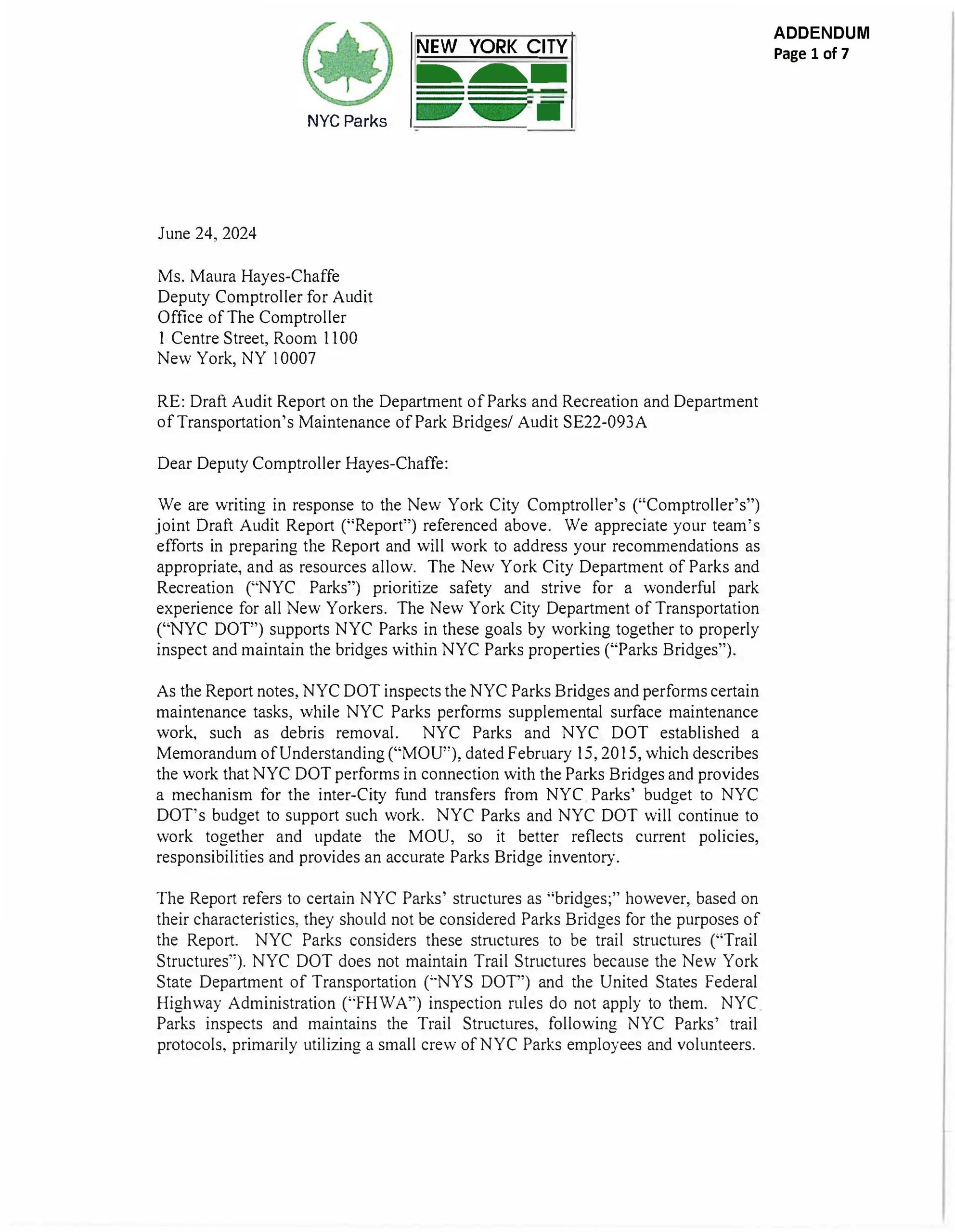
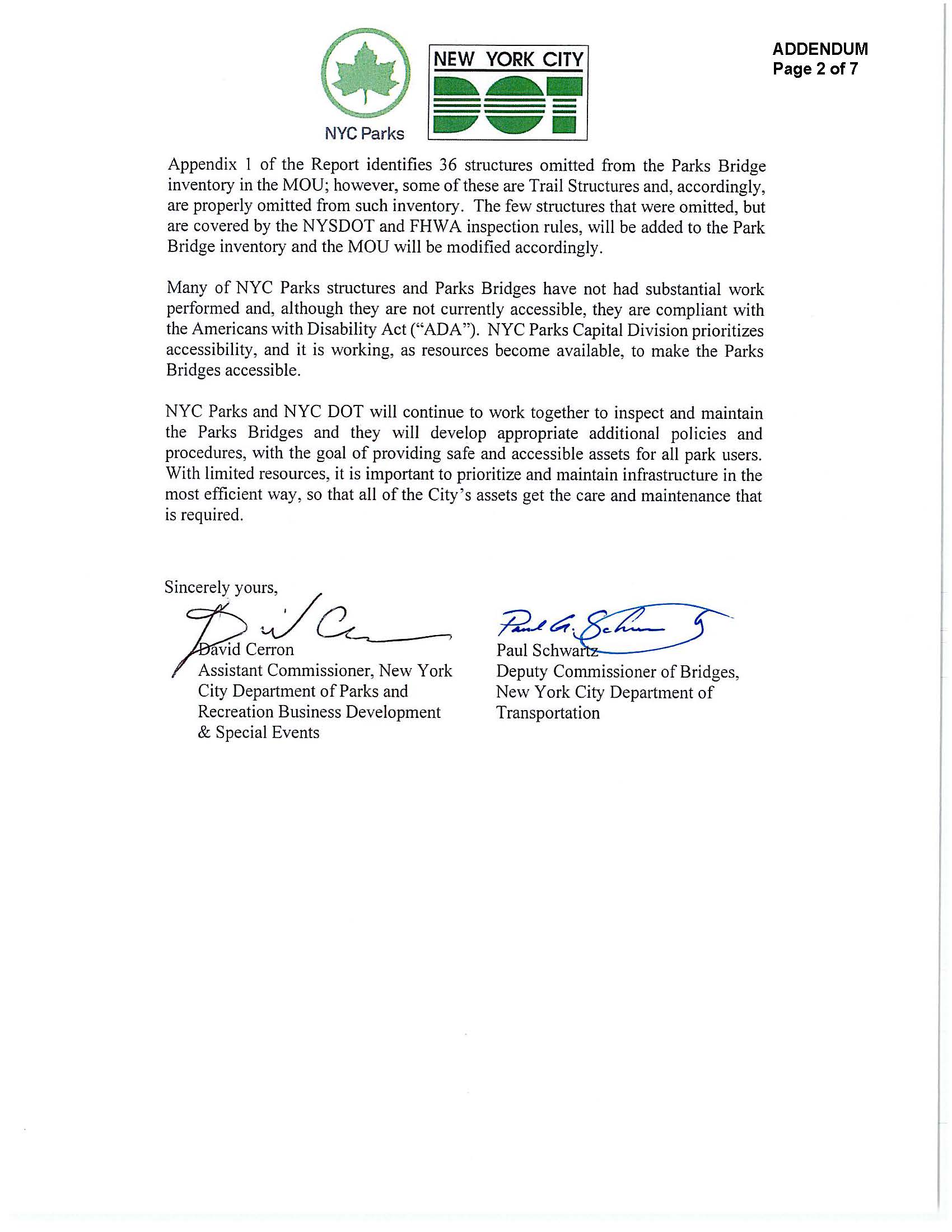
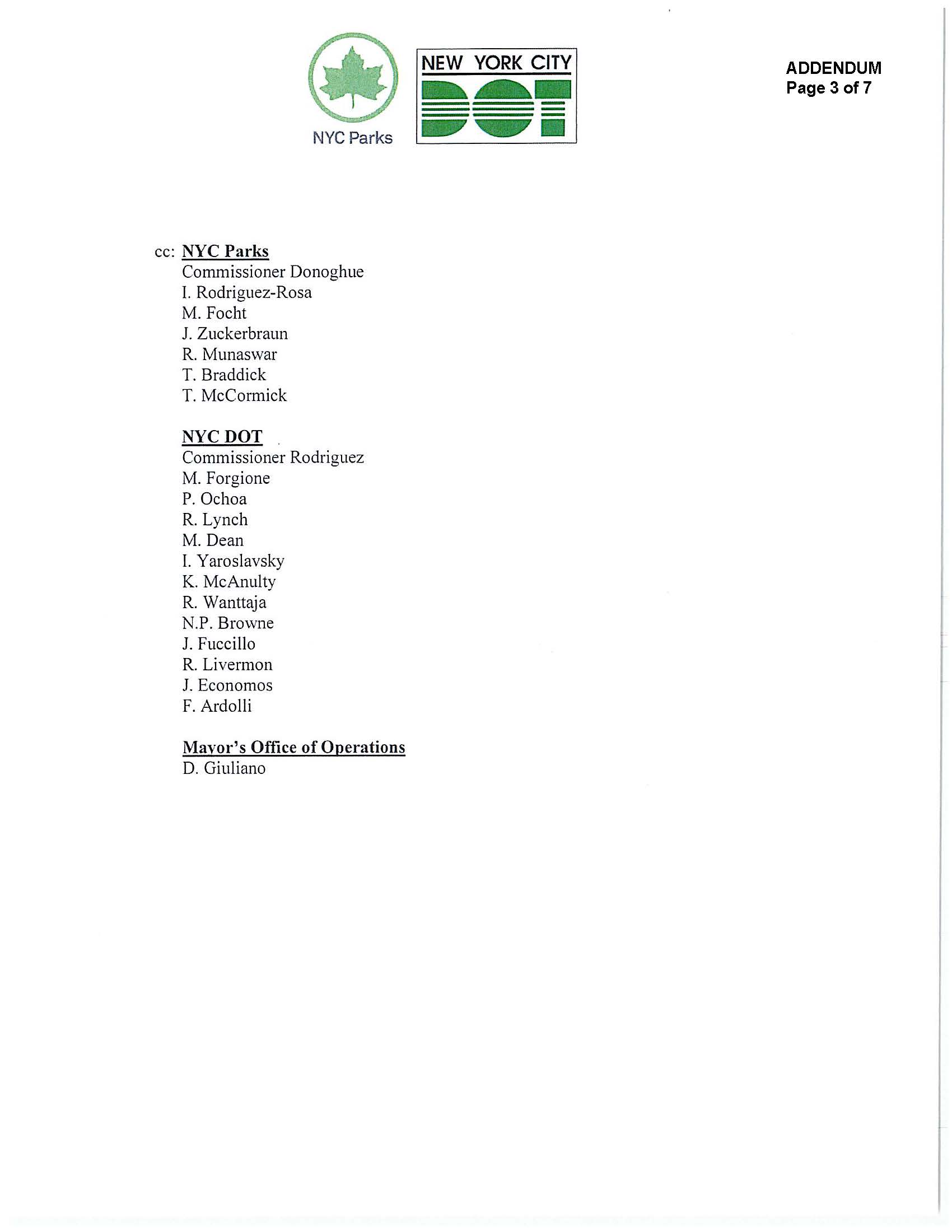

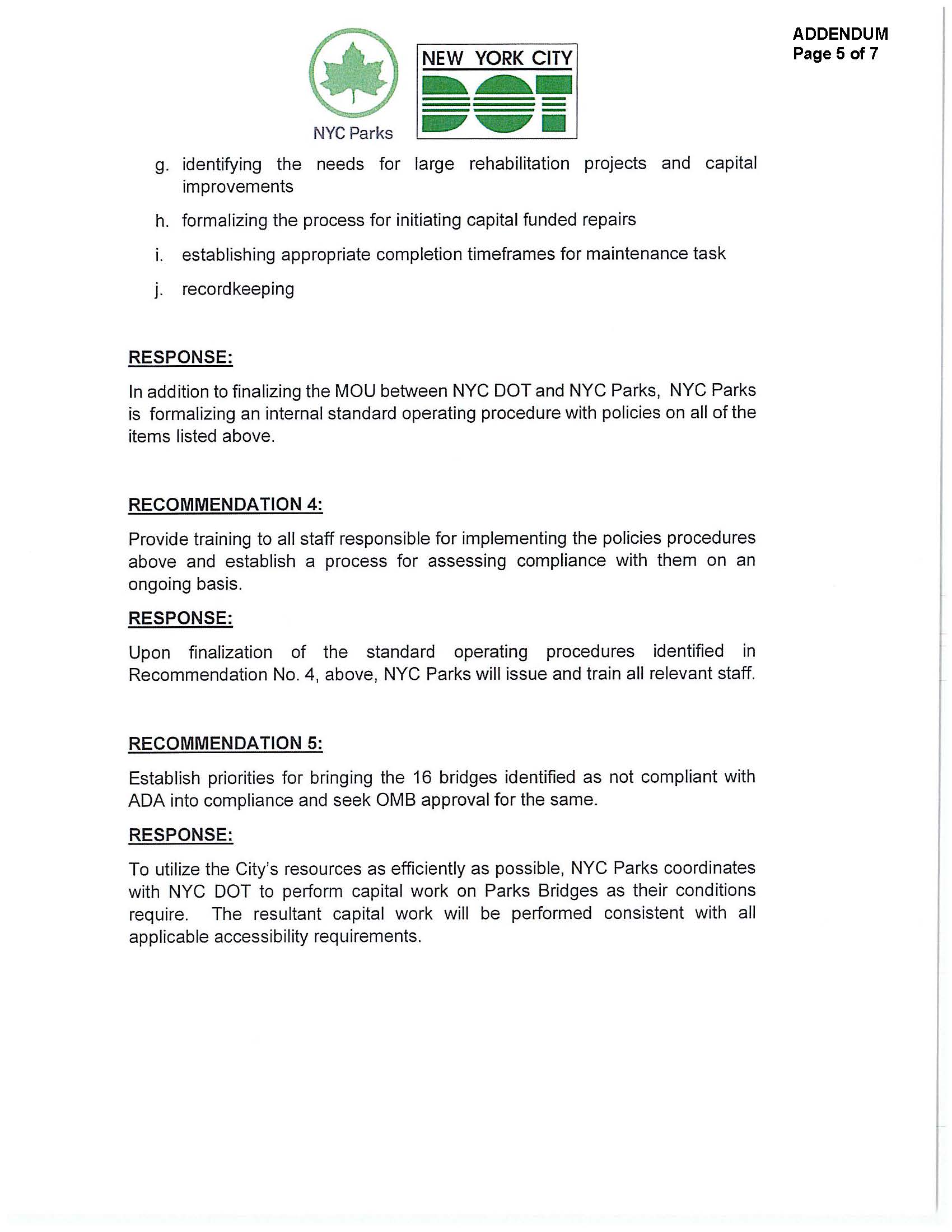
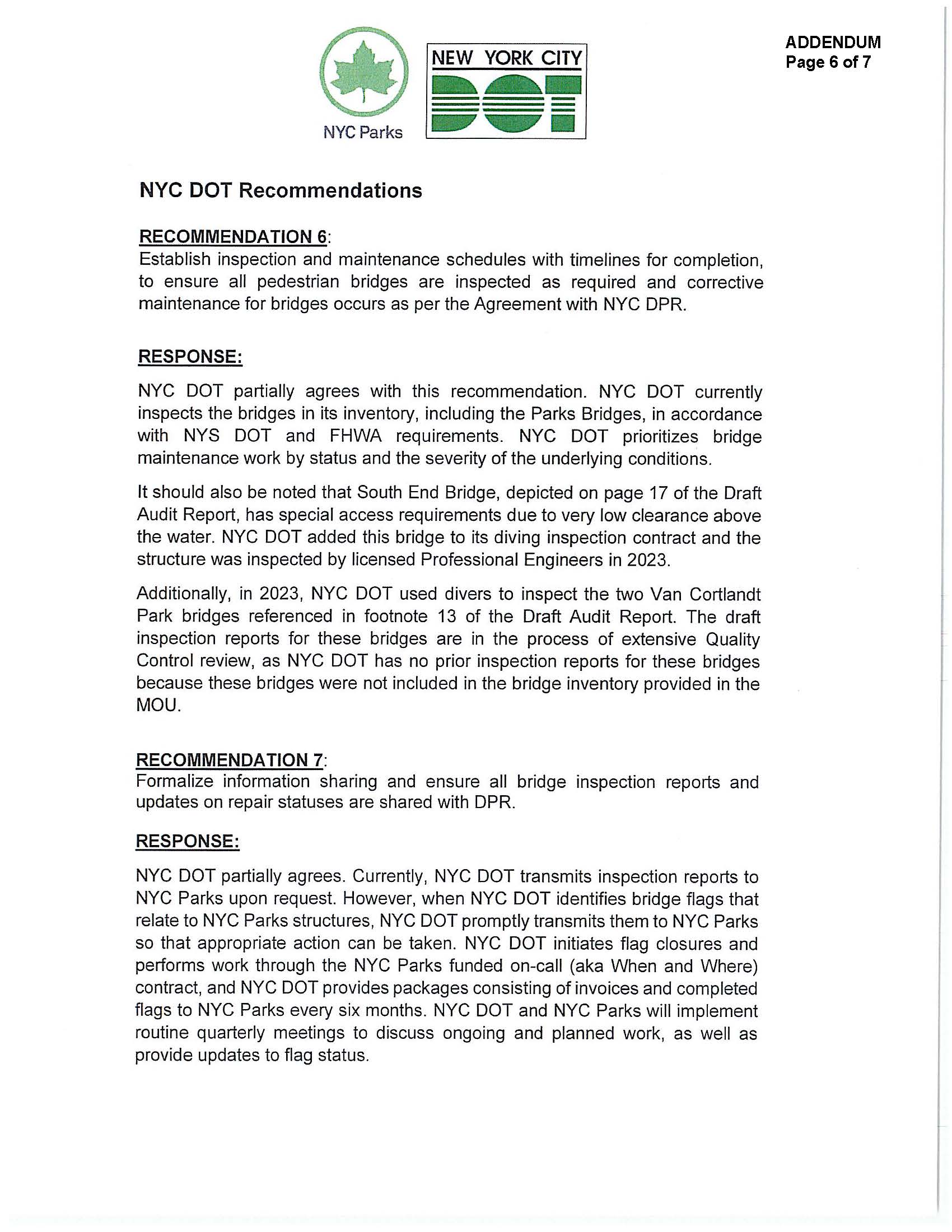
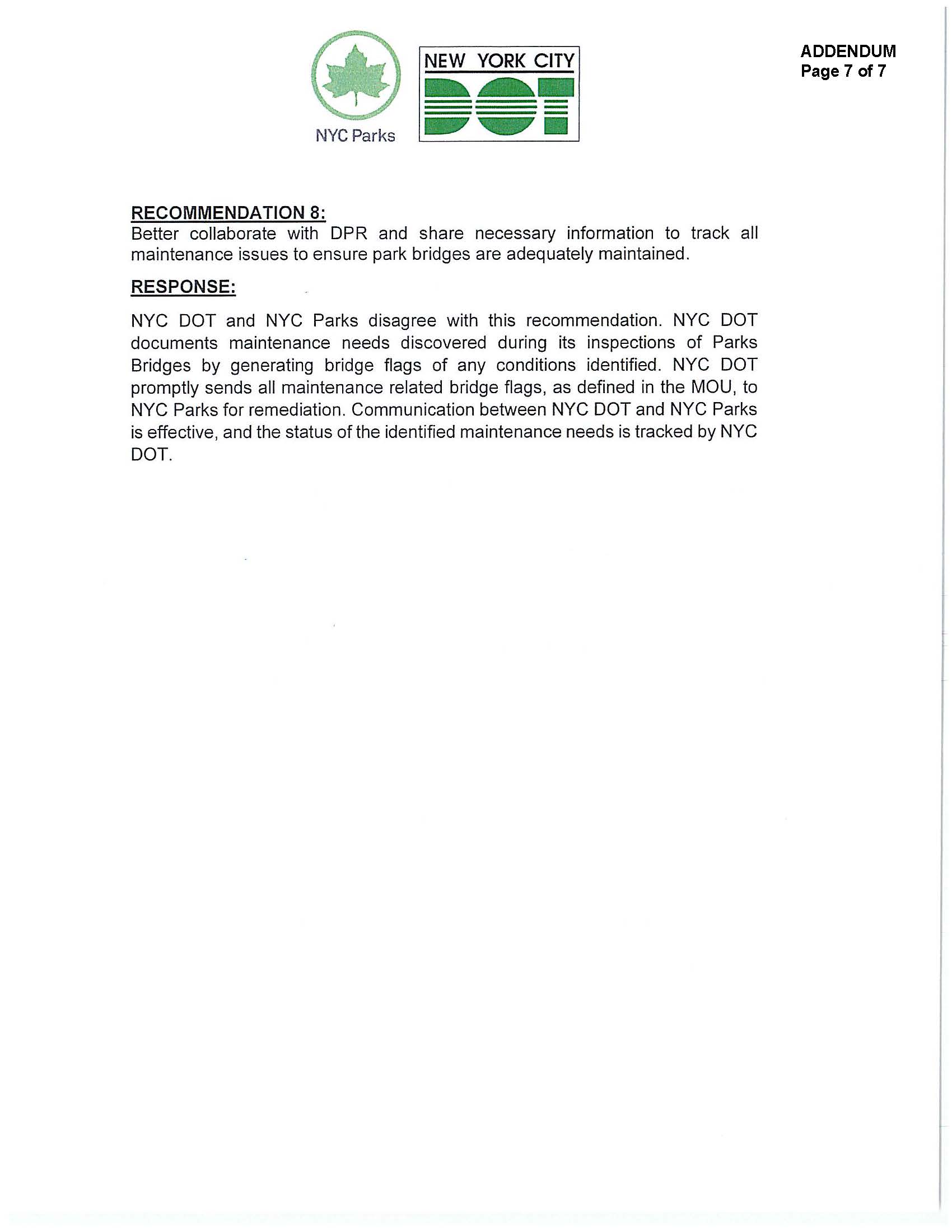
Endnotes
[1] Maintenance includes activities that preserve what is in place such as cleaning, painting, concrete repair, caulking joints, etc. A Capital project includes new capital assets and betterments that improve quality or lengthen the life of a capital asset. A Capital project must exceed $50,000 and have a useful life of greater than five years (Prior to July 1, 2020, the minimum threshold was $35,000). The funding for a Capital project must be approved by the NYC Office of Management and Budget.
[2] There are additional bridges within the parks system that are State-owned or DOT-owned, which DPR is not responsible for maintaining.
[3] As defined in the City DOT Bridges & Tunnels Annual Condition Reports, a bridge is a “structure connecting two points, greater than 20 feet in distance, which carries vehicular and/or pedestrian traffic over water, a descending slope, or another road.” DOT identifies a bridge 20 feet long or less as a Mini-Bridge.
[4] DPR has an agreement with the Central Park Conservancy, under which the Conservancy is responsible for maintaining and repairing bridges in Central Park, while inspections are carried out by either NYS or City DOT. Also, there is an agreement with the Prospect Park Alliance for maintenance of the park’s woodlands, but the Alliance is not responsible for the park’s bridges.
[5] The Flag Engineering Section is an engineering group that reviews, routes, and tracks hazardous or potentially hazardous safety and structural conditions (“flags”) in or on the City’s bridges and vehicular tunnels. Upon evaluation, a “flag packet” describing the required type of repair or response is created and routed to an appropriate group, in-house or contractor, for mitigation. Per DOT, the section monitors the status of each flag, reporting on all activities every month.
[6] Capital funding is not included in DPR’s maintenance budget.
[7] Americans with Disabilities Act (ADA)
[8] NYC Comptroller’s Directive #1, Section 4.4 Information and Communications, states, “Pertinent operational and financial information must be identified, routinely captured, and distributed in a form and time frame that permits people to perform their duties efficiently.”
[9] The auditors visited 24 of the 36 bridges. Information for 20 of the 36 bridges was present in the FY2023 AIMS report for DPR. Two bridges, one in Snug Harbor Cultural Center in Staten Island and the other in Pelham Bay Park in Bronx, were not visited by the auditors, nor did these bridges appear in the AIMS report.
[10] Following the exit conference, according to DOT, the list of 155 bridges has not been finalized. They will finalize and update the MOU after the audit.
[11] AIMS reports, issued by the NYC OMB, detail the condition of City assets requiring State of Good Repair.
[12] See AIMS Report audit: https://comptroller.nyc.gov/reports/audit-report-on-the-compliance-of-the-mayors-office-of-management-and-budgets-asset-information-management-system-reports-with-city-charter-requirements/
[13] Following the exit conference, according to DOT, a diving consultant was hired to inspect the bridge due to clearance issues below the bridge. DOT indicated that two bridges in Van Cortlandt Park were inspected in 2023 by a consultant, and DOT is looking at new technology to assist in future inspections. However, DOT did not specify the BIN numbers or provide inspection reports for two of the three bridges in Van Cortlandt Park it mentioned in its response.
[14] Following the exit conference, DPR stated that the title of the cited trail structure inventory has been revised. DPR also provided instances of three distinct trail structures categorized broadly as “Trail Crossings,” each accompanied by specific terminology, prepared by its Natural Resources Group, in January 2023.
[15] Also, it cannot be confirmed whether the data only contains park bridges.
[16] A Bridge in Riverside Park, the Riverside Park Overbuild, is the roof of an Amtrak tunnel. It was not suitable for inspection.
[17] DOT provided all necessary reports for 24 of the 25 vehicular bridges over 20 feet long that NYS DOT inspects.
[18] The ADA protects the rights of people who have a physical or mental impairment that substantially limits their ability to perform one or more major life activities, such as breathing, walking, reading, thinking, seeing, hearing, or working.
[19] It should be noted that some bridges at some locations were demolished, with new replacement bridges currently in design or construction phases. A bridge in Freshkills Park is planned, and a project in Van Cortlandt Park was canceled.
[20] A bridge was designed to be ADA accessible, rehabilitated to be ADA accessible, or met the current requirements when originally built regardless of the year it was built.
[21] Federal Regulations – 35.151 of 28 CFR Part 35 – Construction Projects which commenced after January 26, 1992, had to comply with 1991 ADA Standards. Construction Projects that commenced on or after March 15, 2012, had to comply with 2010 ADA Standards, which are still current as of this writing.
[22] Though most bridges generally meet accessibility standards, corrections are needed in certain features like continuous handrails, ramp slopes, and stable, slip-resistant walking surfaces to serve individuals with disabilities better. Of the 24 ADA-accessible bridges, six were found to have issues like broken or intermittent handrails and insufficient handrail lengths, affecting both ADA compliance and user safety, 11 bridges did not appear to have any ADA or safety issues, and for the remaining seven, the auditors could not determine or comment on their status based on the available information. Of the 16 inaccessible bridges, some bore evidence of safety hazards such as uneven surfaces, protruding objects, broken glass, wet leaves, clogged drains, holes in fences, exposed wires, and broken or malfunctioning lights. All of these hazards contribute to unsafe conditions. Overall, 22 of the 45 bridges had either ADA or safety issues, but these issues are not localized to any particular geographic area.
[23] Also, two ADA-accessible pedestrian bridges are being constructed over the Belt Parkway in Brooklyn. The existing bridge at the 17th Avenue location was already demolished. The existing bridge at 27th Avenue is still in use. Work on these two bridges is estimated to be completed in 2024. The bridge at 17th Avenue provided and will provide access to the waterfront along Gravesend Bay with views of Staten Island and Verrazzano-Narrows Bridge. The bridge at 27th Avenue provides access to Calvert Vaux Park and Six Diamonds Park.
[24] The auditors used the DOT reports as the starting point to establish the population of bridge structure assets under DPR’s jurisdiction.
[25] Auditors researched NYC Open Data Reports on the NYC.gov website to determine how many bridges are the property of DPR.
[26] Auditors interviewed DPR officials, including DPR’s Assistant Commissioner for Concessions and Internal Audit, Chief of Architecture and Engineering, Chief of Inspection and Internal Audit, Director of Internal Audit, and Chief of Staff of IT. Auditors also performed walkthrough meetings with the Architecture, Engineering, and Capital Needs Assessment division and with the Environment and Planning division.
[27] Initially, DOT provided the requested information relevant to the audit. Later, however, it was determined that DOT played a more significant role than initially anticipated. Considering the extent of DOT’s involvement in the maintenance of park bridges and anticipated staff time to administer auditors’ information requests, DOT was officially added as a co-auditee on the audit.
[28] For Equity analysis, the auditors relied on the data maintained by DCP, which used data from the 2020 Census, American Community Survey (ACS) for Household Income, and data obtained from DCP Community District Profiles in reference to “Access to Parks.” According to DCP, “Access to Parks” statistics were obtained from DPR 2016 data. DPR considers walking distance to be 1/4 mile for parks less than six acres, and 1/2 mile for larger parks and pools.